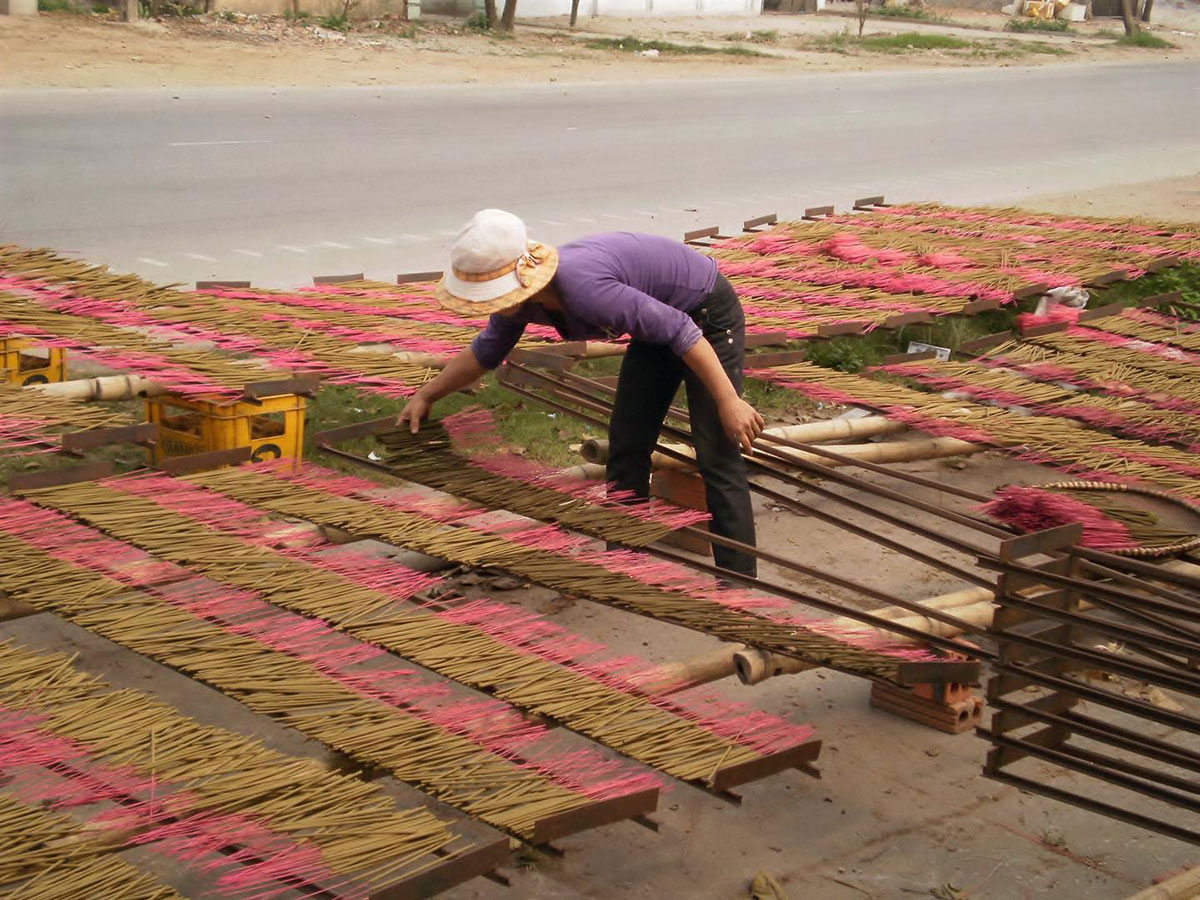Photos from Vietnam
Photos from Vietnam, contributed by AFSA members
All photos and captions were submitted courtesy of the AFSA members named below and are organized into the categories Wartime (photos taken during the Vietnam War and photos of people and places encountered during the war), In Between (photos taken after the war, but prior to the Vietnam of today), and Modern (photos of contemporary Vietnam).
Links:
Wartime
Jose Armilla
click here to return to the top of the page ↑
Jose Armilla was a Research officer with USIS at American Embassy Saigon from 1973-1975.

Youth helping refugees in floating basket - When Communist forces finally overran South Vietnam, refugees fleeing the country became known as the “Boat People.” Many escaped in fishing boats. In Nha Trang, Central Vietnam, there was a large fishing fleet offshore. Youngsters such as this one helped ferry refugees from shore to waiting boats by using this traditional mode of transport. One is reminded of the American suburbanite’s custom of gifting a new neighbor with a “welcome basket,” but for the Vietnamese refugee, the floating basket represented the gift of freedom. September 27, 1974, Nha Trang, Central Vietnam.
Anton Cistaro
click here to return to the top of the page ↑
All photos date from between 1964-65, when Mr. Cistaro was working as Province Representative to Chau Doc Province Chief.

Meeting with village representatives to explain how the Self Help program works.
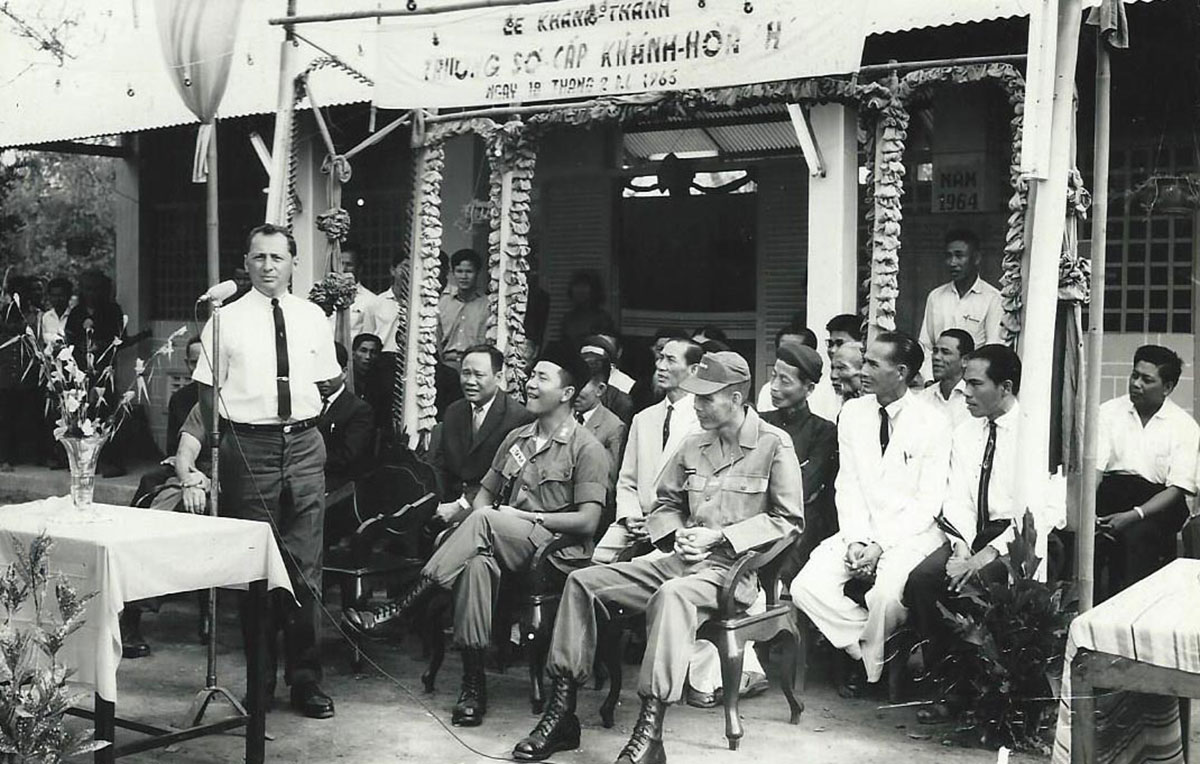
Speaking to villagers at a new school dedication.

Meeting with farmers to facilitate an experimental corn project.
C. Robert Dickerman
click here to return to the top of the page ↑
C. Robert Dickerman was a Foreign Service Officer with USIA from 1962-1992, and served with JUSPAO in My Tho and Moc Hoa, Vietnam, from 1965-1967.

Boat trip: JUSPAO Field Rep Bob Dickerman accompanying a psywar musical troupe to a hamlet in the Delta. 1966.

Food Distribution: JUSPAO Field Rep Bob Dickerman, with the Kien Tuong province chief, distributing food packages in the flooded Plain of Reeds. 1967.
Dennis Donahue
click here to return to the top of the page ↑
Dennis Donahue served as USIS Publications Officer in Saigon.
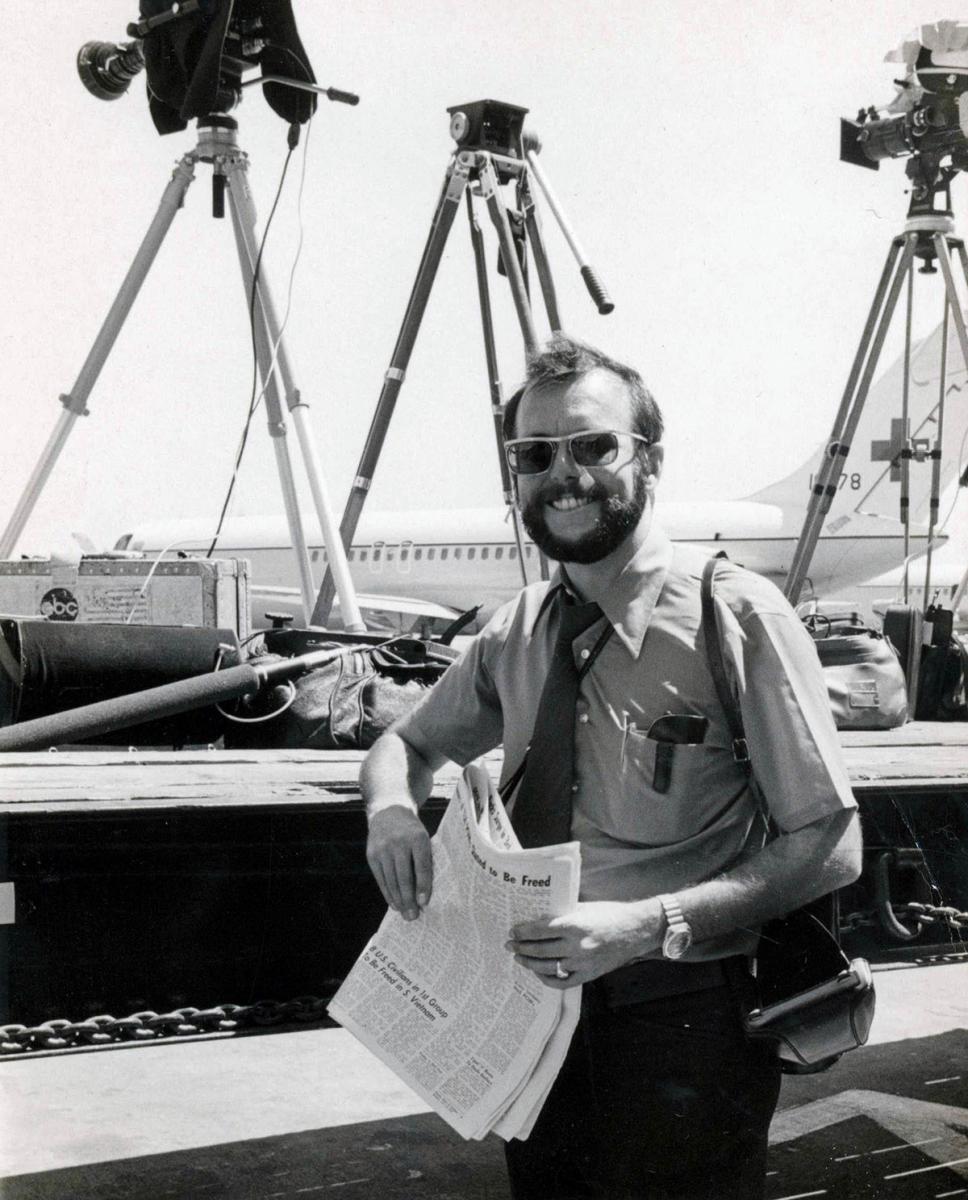
Covering the return of American POWs at Saigon’s Tan Son Nhut airport, February 12, 1973. Note the Stars and Stripes newspaper with article on the POW release and the C-9 “Nightingale” hospital aircraft in the background. Click here to read more.
Bill Graham
click here to return to the top of the page ↑
Bill Graham served as CORDS Assistant District Advisor, in Cai Be District, Dinh Tuong Province from 1968-1970.

Bill Graham (with hat) discussing a project to reopen the Thanh Phu Village canal in Chau Thanh District. Dredging for the U.S 9th Division’s Dong Tam base had filled in the canal, and the Army refused to help us dig it out. We used CORDS Aid In Kind money and surplus food commodities to compensate villagers for digging out the silt. It was nearly a kilometer long and it took about 3 months to get done. Everyone was happy with the arrangement. (January 1970)
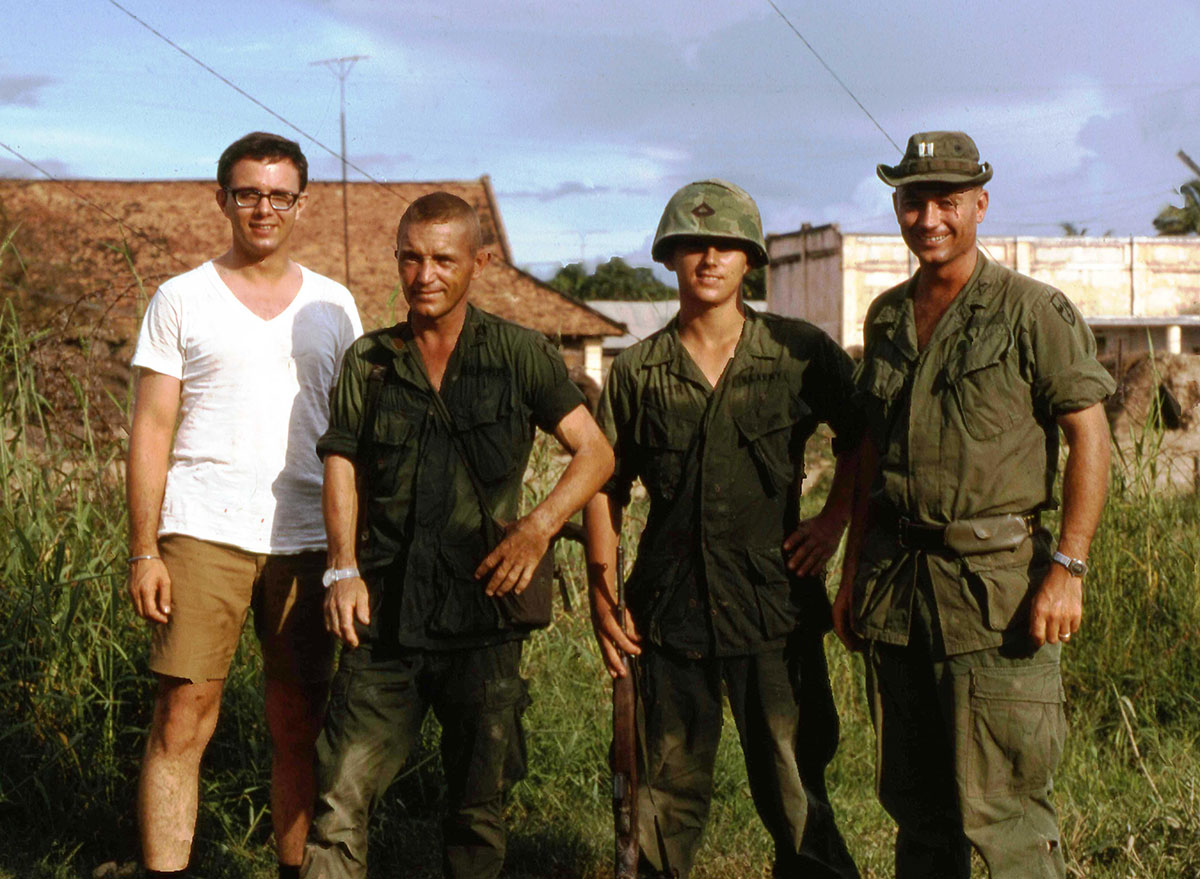
CORDS advisory team in Cai Be District about 35 miles west of My Tho, where Graham served as assistant district advisor for civilian affairs. Next to Bill Graham is district advisor Major Bill Elsten, administrative assistant Spec. 4 Parker, and Captain Rick Gillespie. They had just returned from an all day hike through the paddies. Graham spent about 15 months in Cai Be and paid it a return visit in 2001.
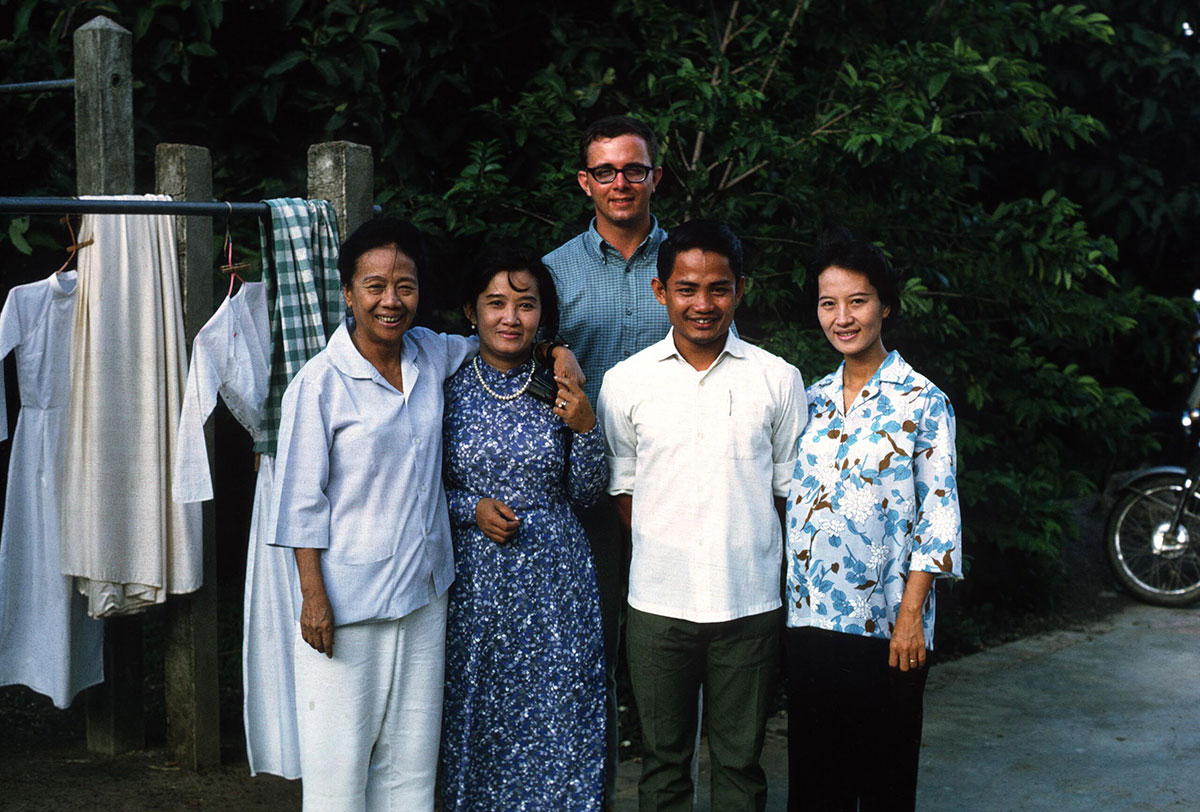
Dr. Bui Quang Chieu (left) with one of her nurses, Mr. Truong Van Nghiep, Cai Be District’s Health Officer, and his wife. Bill Graham is in the background. Dr. Bui was leader of the Asian Christian medical missionary group and the first Vietnamese woman ever to have graduated from a western medical college, the Sorbonne in Paris. Graham and his partners used CORDS AIK money, village labor and materials from the U.S. 9th Division to rebuild Cai Be’s civilian dispensary. Dr. Bui and Nghiep were genuine heroes who saved many civilian lives in the District. Graham’s advisory team collaborated with her group regularly. (September 1968)
Michael Hacker
click here to return to the top of the page ↑
Michael Hacker served as a Vinh Binh Province Chieu Hoi Advisor, and retired from the Foreign Service in 1997.
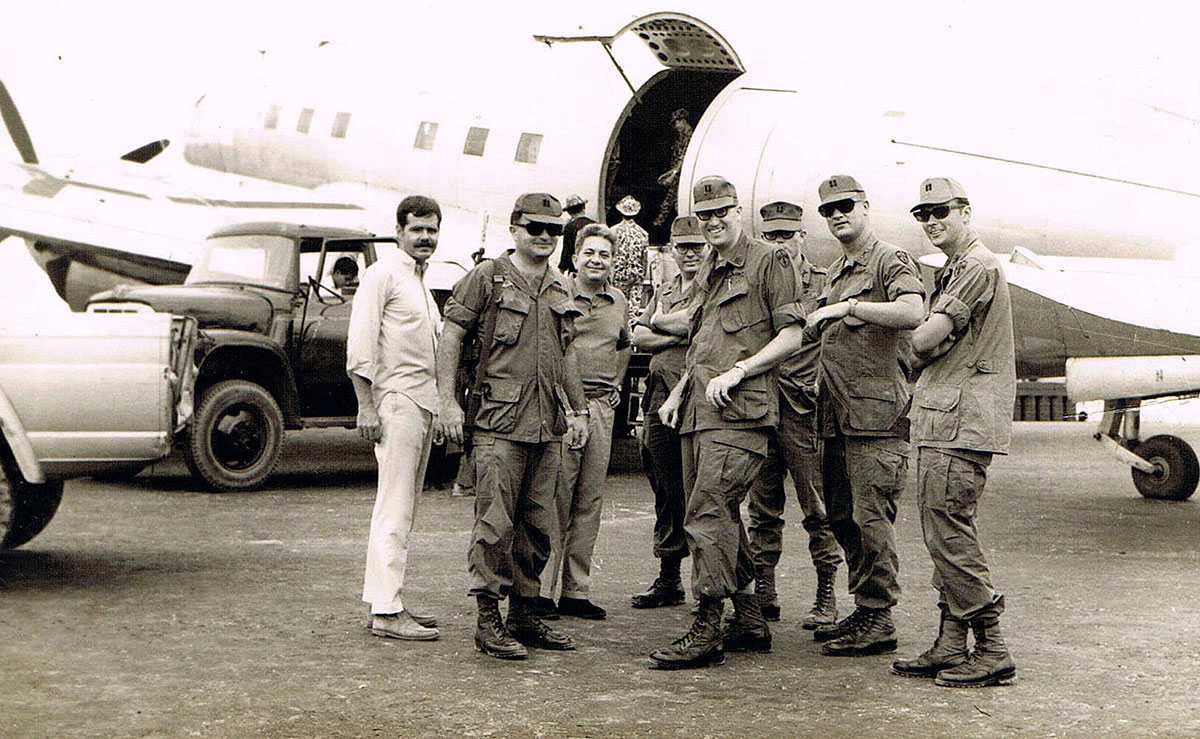
Captain Plotkin: A group of military and civilian province advisors saying “goodbye” to a friend who had just completed his tour of duty in Vietnam. From left to right: Michael Hacker, Province Chieu Hoi Advisor; Captain Ben Plotkin, S-2 (intelligence officer); Bob Goodenough, JUSPAO Advisor; U.S. Army Captains Carpenter, Moore and Delp, at Vinh Binh Province airstrip for the DEROS (Date of Estimated Return from Overseas) of Captain Ben Plotkin, Advisory Team 72, August 1969. When a U.S. military man reached his DEROS, he was eligible to go home, ie. back to the United States. Click here to read more.

Vinh Binh 1969: This Viet Cong road mining of a civilian bus caused the deaths of 26 men, women and children. There were no survivors. This photo was taken on the road from Vinh Binh provincial capital, Tra Vinh, to Tieu Can District, July 1969. Michael Hacker is wearing sunglasses, facing the camera, with chest strap. Click here to read more.

Hoi Chanh Graduates: Michael Hacker, Vinh Binh province Chieu Hoi Advisor, presents a graduation certificate to Hoi Chanh, a former Vietcong soldier at the Chieu Hoi Program Graduation Ceremony, in Tra Vinh, Vinh Binh Province, July 1969.
George Lambrakis
click here to return to the top of the page ↑
George Lambrakis was in the first group of junior officer trainees recruited by the U.S. Information Agency in 1954 after a government-wide recruiting pause ordered for budgetary reasons by President Eisenhower. He served in Saigon, 1954-55, and established the first two USIS field posts outside of the capital, Vientiane, in southern Laos at Savannakhet and Pakse, 1955-56, before returning to Washington and entering the State Department Foreign Service in January 1957.
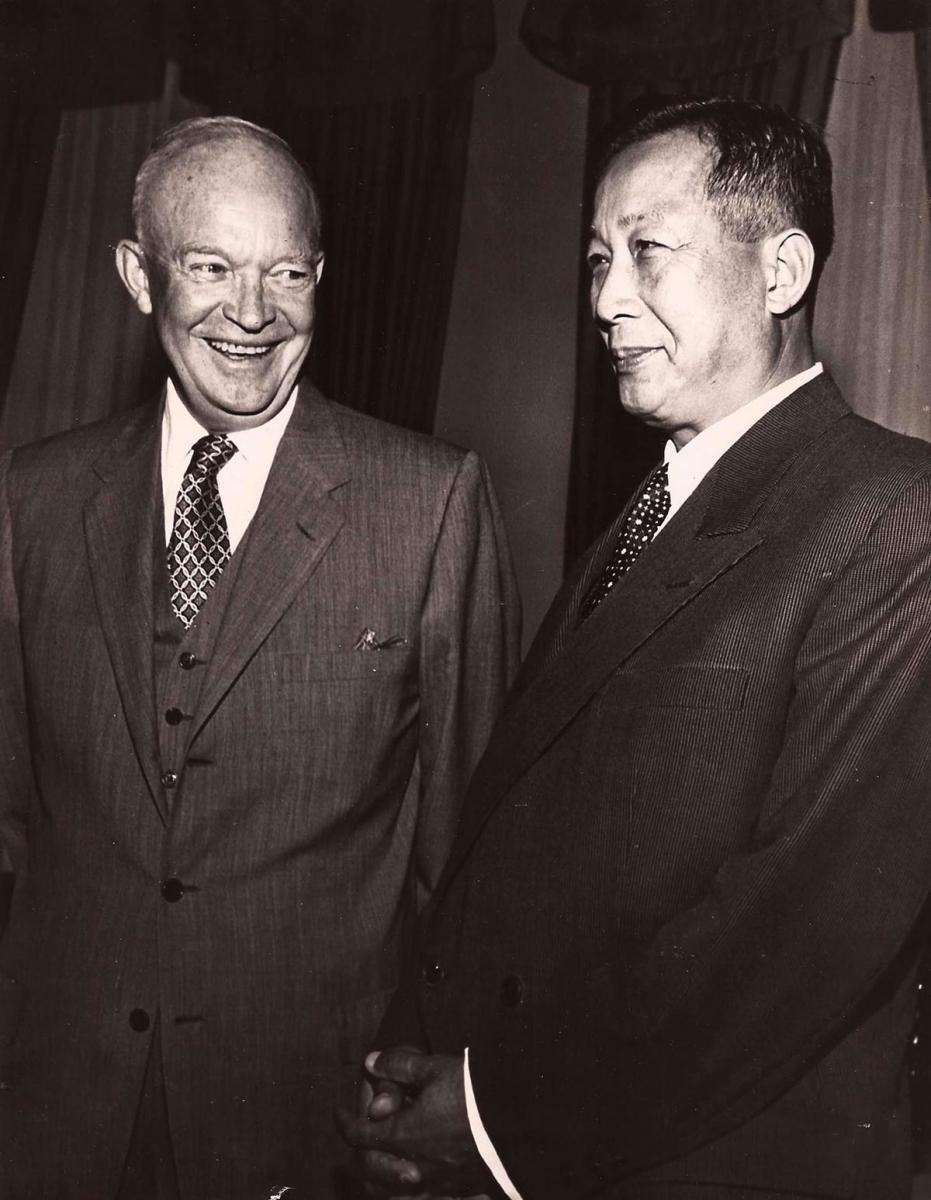
Eisenhower and President Ngo Dinh Diem: President Eisenhower with President Ngo Dinh Diem's ambassador in Washington. Eisenhower refused a request from the French for a nuclear strike in their losing battle at Dien Bien Phu.Betting on Ngo Dinh Diem, President Eisenhower sent Colonel Edward Lansdale to help the South Vietnamese. Lansdale had just become famous for helping the Philippine government suppress a Communist insurrection in its southern islands (at a time when Sukarno, seen a pro-Communist, still ruled in Indonesia, and there was fear of a Sino-Soviet takeover of the weaker “dominoes” of Southeast Asia). Lansdale and his two younger military assistants shared an office at first with our small USIS staff (less than a dozen). One of those assistants, Rufus Phillips, reportedly mentored the young Richard Holbrooke once the Americans had entered the war a decade later. “Operation Brotherhood” was an additional effort to draw South Vietnam into the anti-Communist resistance signalled in the Philippines.

President Ngo Dinh Diem at a mass rally with children. An anti-Communist, but also anti-French nationalist, he won American support, which many French in Indochina resented. Two French junior army officers were caught by the Vietnamese in the process of planting bombs at American installations (one thrown at the American library just below the author's apartment, another on his front landing, which was shared by the Embassy's chief of security).
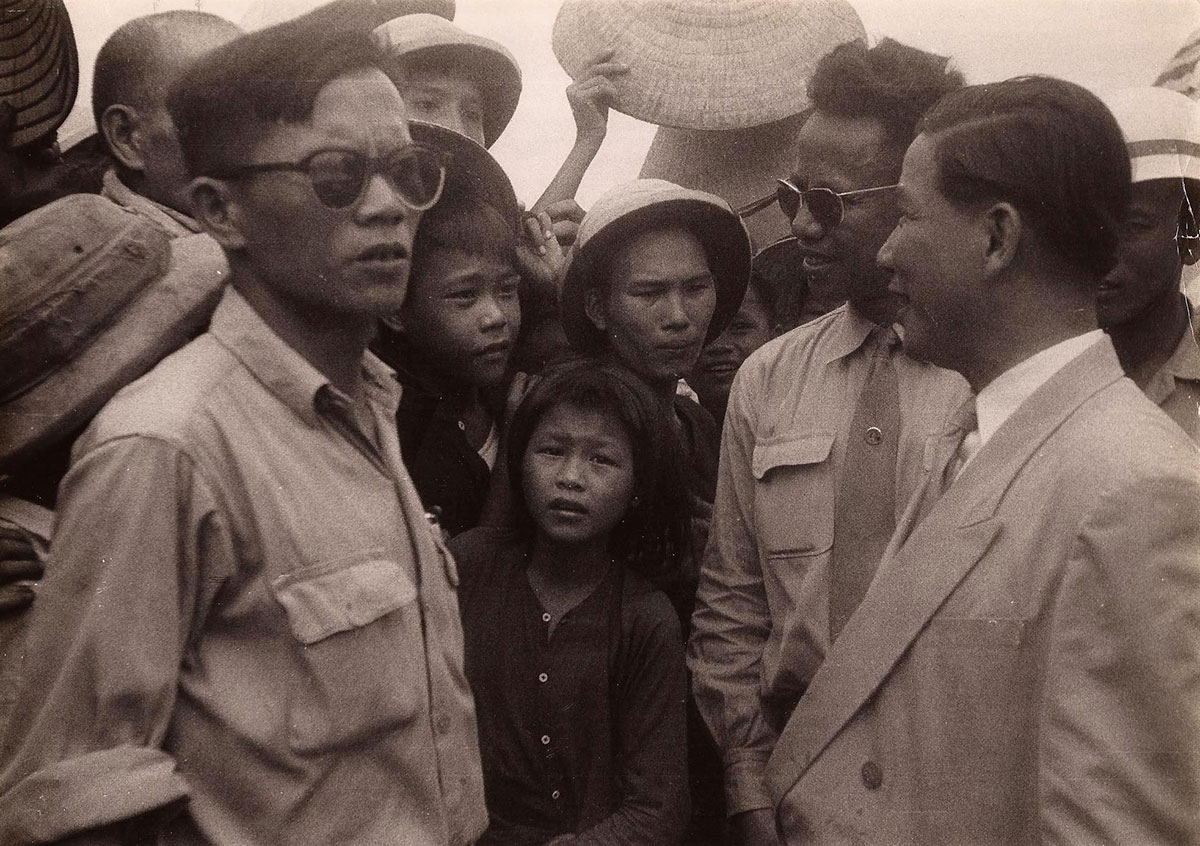
(See caption from previous photo)
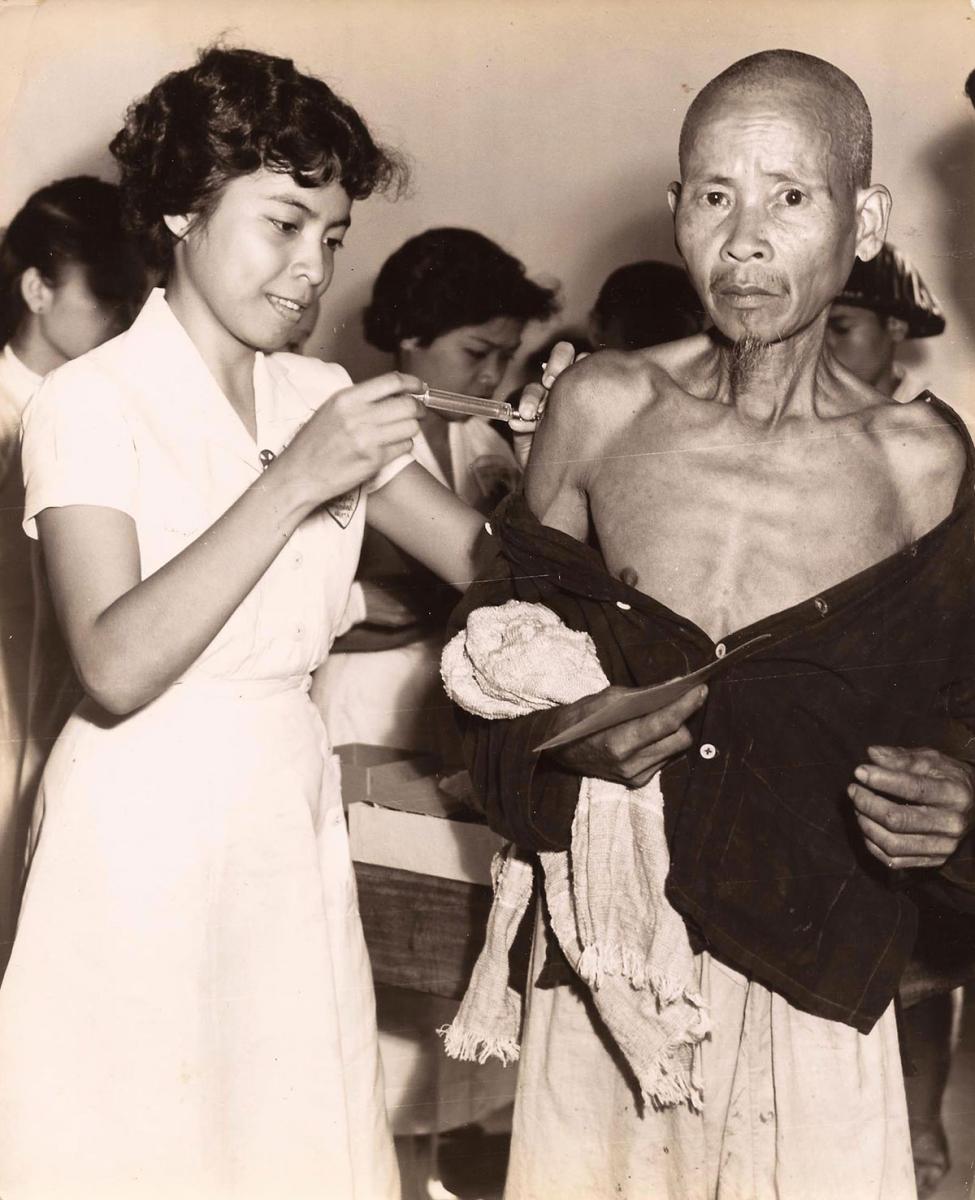
Operation Brotherhood: “Operation Brotherhood” brought Filipino doctors and nurses to South Vietnam, with American assistance.

Warfare in Saigon: Warfare between the army and the French-recruited police, who were supported by the Binh Xuyen gang that controlled gambling and other crime, burned down sections of Saigon. The bet was that Diem would not last more than three months, and South Vietnam would fall to the Communist North within six months.
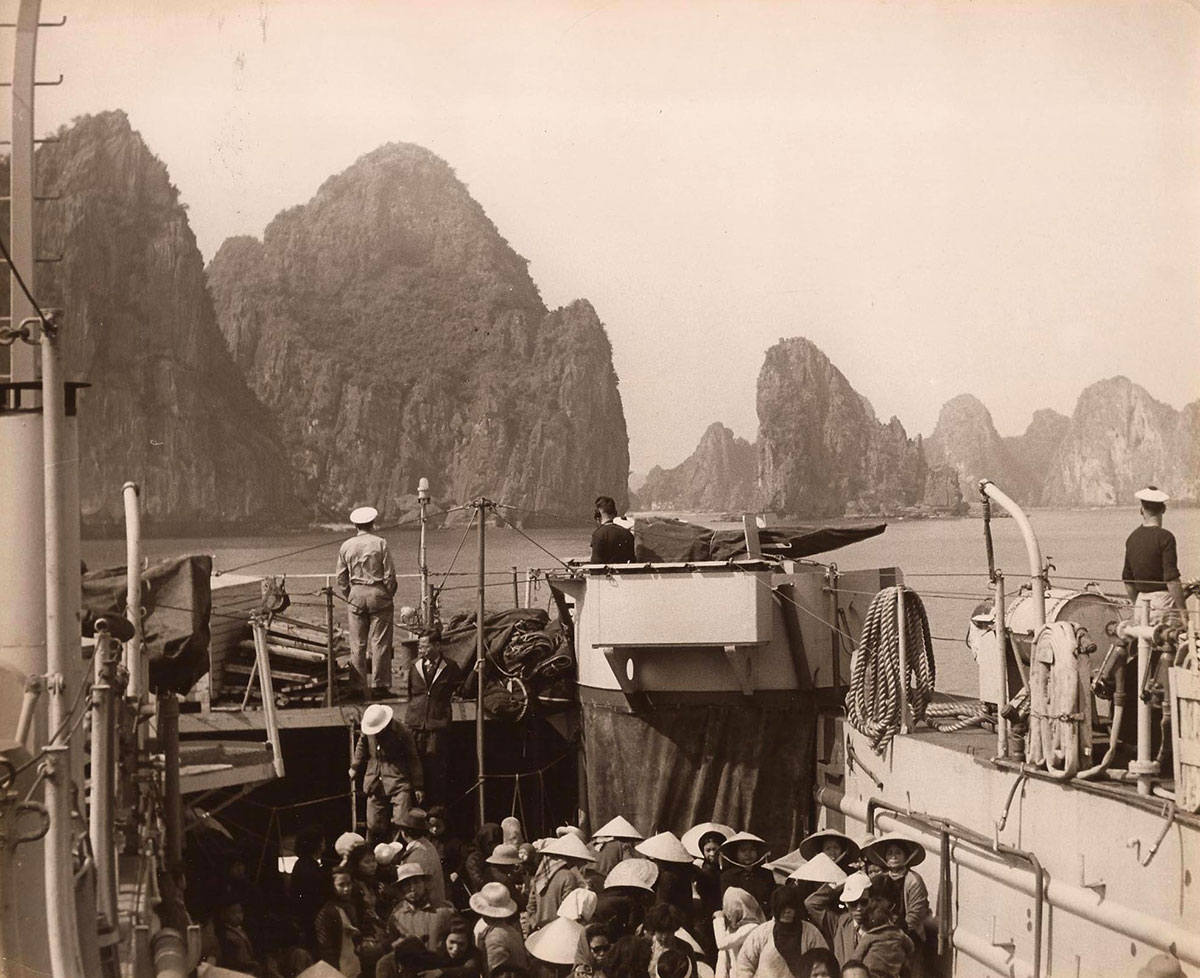
French and U.S. Navy ships: French and U.S. navy ships transported almost a million Northern Catholic families fleeing the Vietminh (later Vietcong) from the port of Haiphong to Buddhist South Vietnam (whose president, Diem, was also Catholic).
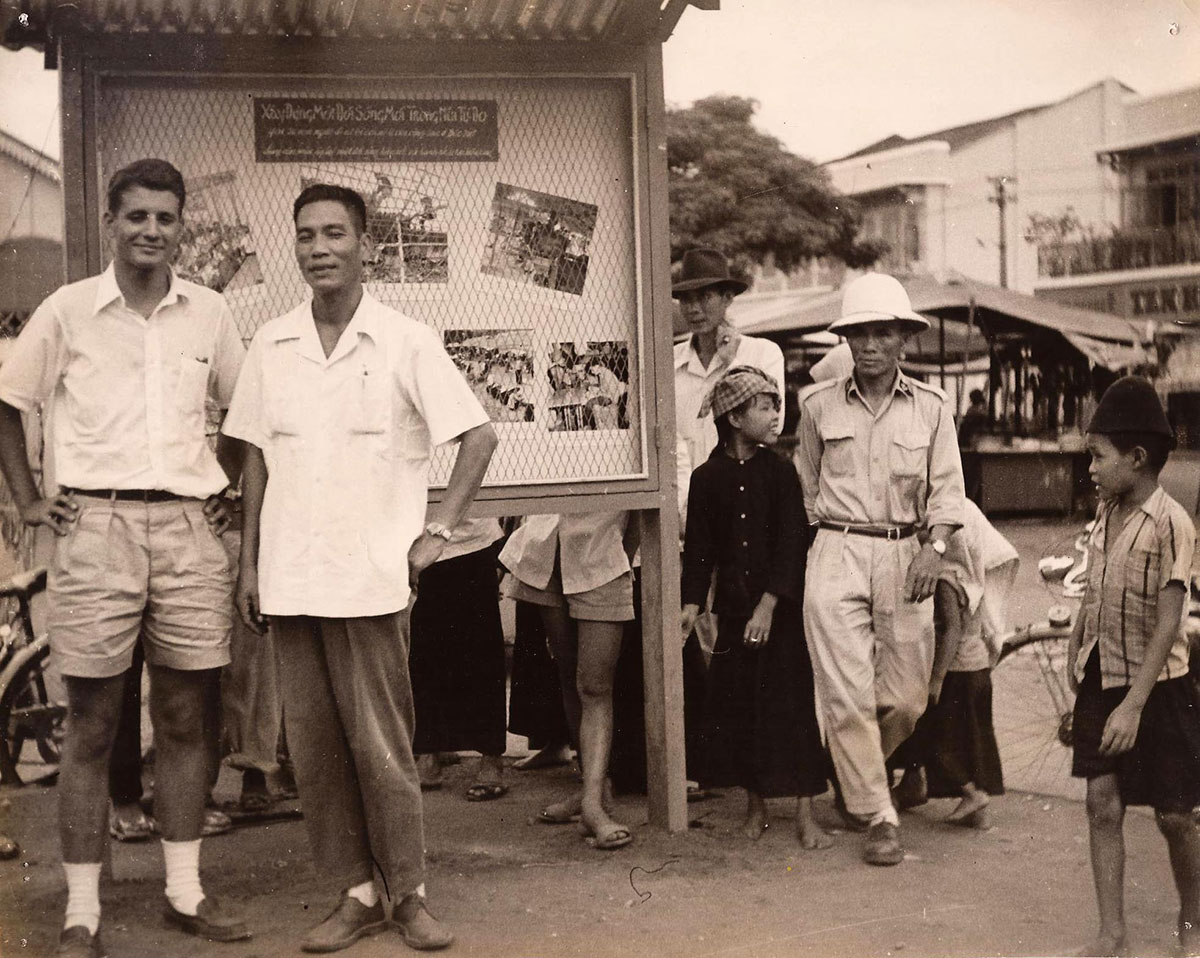
George Lambrakis: George Lambrakis, one of the first recruits in USIA's new program of junior officer trainees, with his Vietnamese assistant in front of a USIS bulletin board in a South Vietnamese provincial town. On another occasion villagers gathered around him while an older local made fun of President Diem's photo asking why he did not have a beard like Ho Chi Minh. The USIS translator insisted that we make a quick exit.

Vietnamese kids gather around USIS representatives.
Christina Le
click here to return to the top of the page ↑
Christina Le is currently a Philippines Desk Officer in the Bureau of East Asian and Pacific Affairs at the State Department.
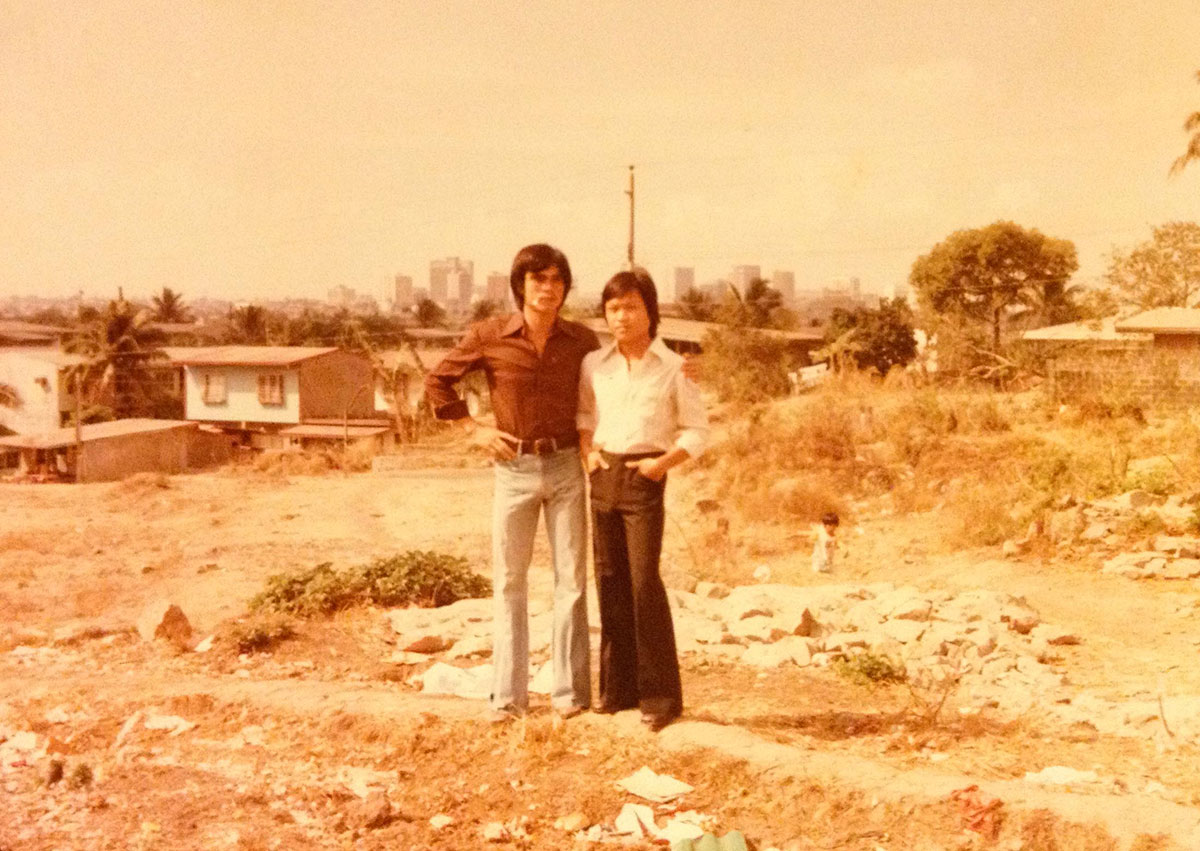
Her father at Manila refugee camp: Christina Le’s father, Den Q. Le, at the Jose Fabella refugee camp in Manila after fleeing Vietnam. He swam to shore from a boat.
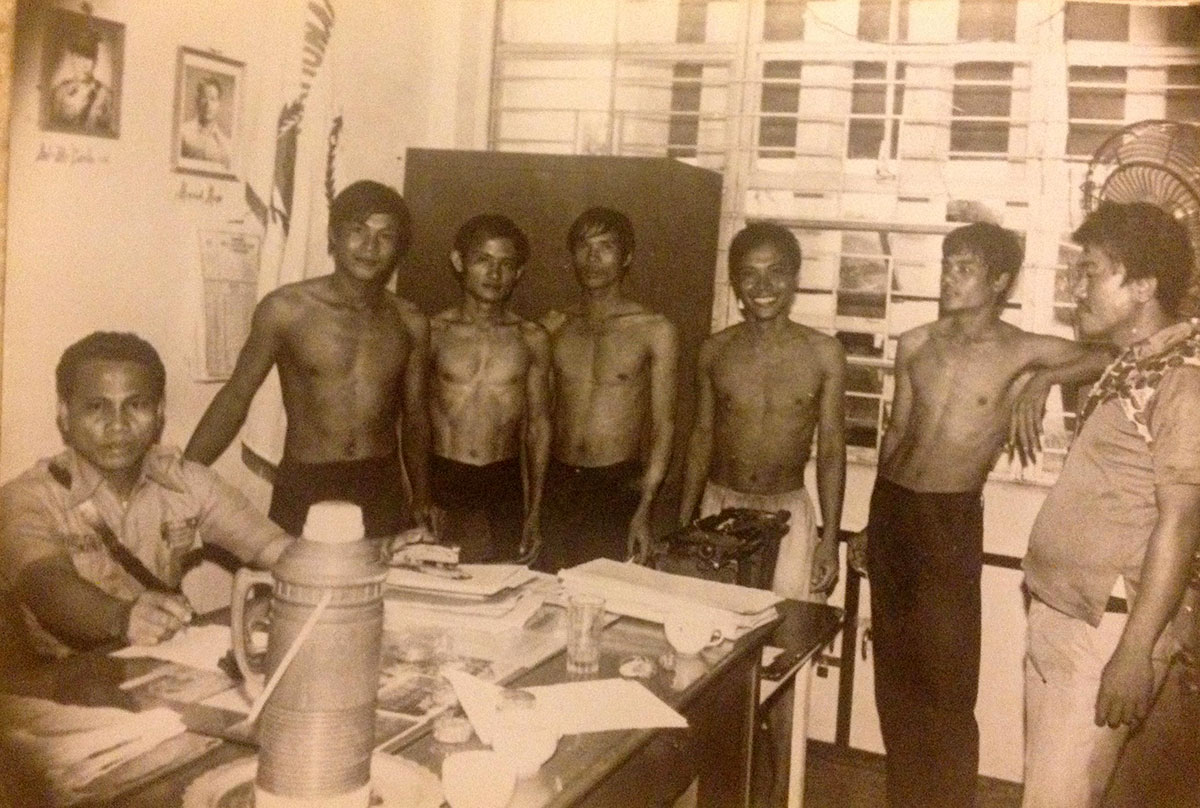
Six male refugees: Filipino officials took photos of the six Vietnamese men who travelled in the same boat as Den Q. Le, as well as the materials they brought with them.

Group shot at the Manila refugee camp: Den Q. Le is part of this group shot of refugees at the refugee center in Manila.
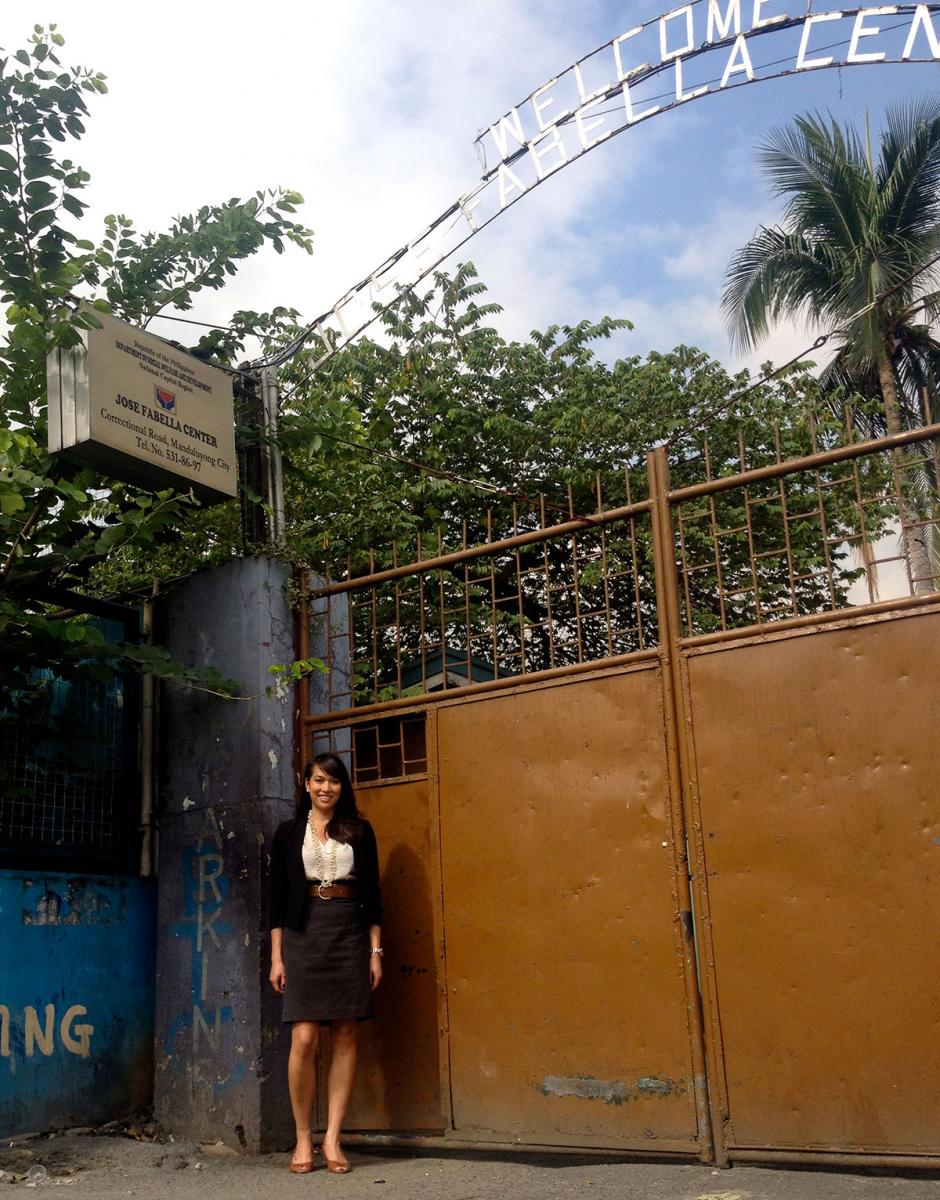
Christina at the camp today: Christina Le is a Vietnamese-American FSO who recently traveled to Embassy Manila as part of her familiarization trip as the Philippines Desk Officer. The Embassy arranged a visit to the refugee center in Manila that hosted her father in the 1970s when he fled Vietnam. The center is now a shelter for TIP victims, the homeless, and third-country nationals, and also hosted many affected by Typhoon Yolanda in 2013.
Vladimir Lehovich
click here to return to the top of the page ↑
Vlad Lehovich and Dick Holbrooke were the first Foreign Service Officers to be detailed to AID to serve with this program and started work with USOM in May, 1963. Vlad was an FSO-8 when this picture was taken. He is retired and lives in Washington, D.C. Hao T. Nguyen (Nguyen Thai Hao) lives in Gainesville, Florida.
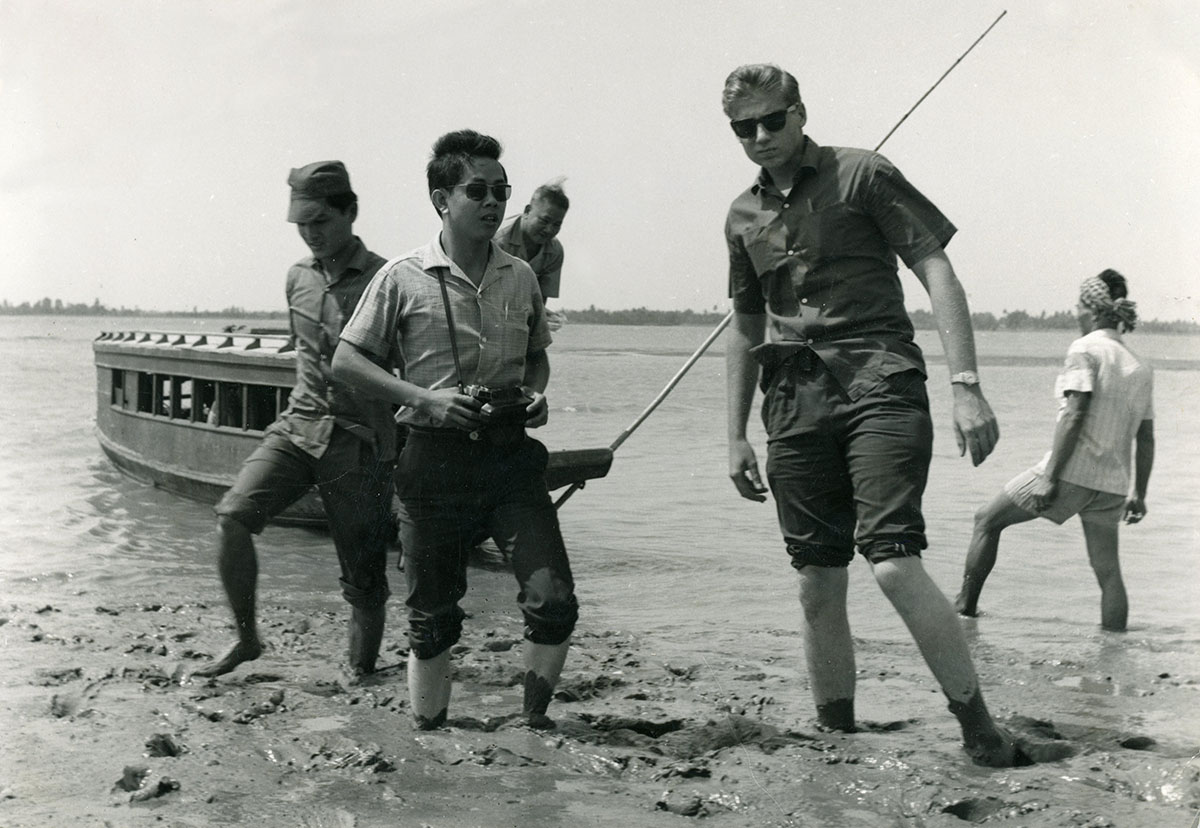
In the Mud in Binh Minh: This photo, from late 1963, shows Vladimir Lehovich (front right) landing at a remote part of Binh Minh District in the Mekong Delta province of Vinh Long. With Vlad are (left front ) Dinh Van Gam of USIS and (center front) Nguyen Thai Hao of USOM/RA. At center rear, disembarking, is a provincial official. As a provincial representative for USOM/Rural Affairs, Vlad was visiting a remote area of the province with local officials to assess possibilities for rural development projects, and, in collaboration with USIS and provincial information officials, to distribute information about project opportunities for local residents. Click here to read more.
Jim Meenan
click here to return to the top of the page ↑
Jim Meenan is a former USOM (USAID)/ Vietnam Senior Local Currency Officer. Now retired, he is a member of the AFSA PAC Advisory Board.
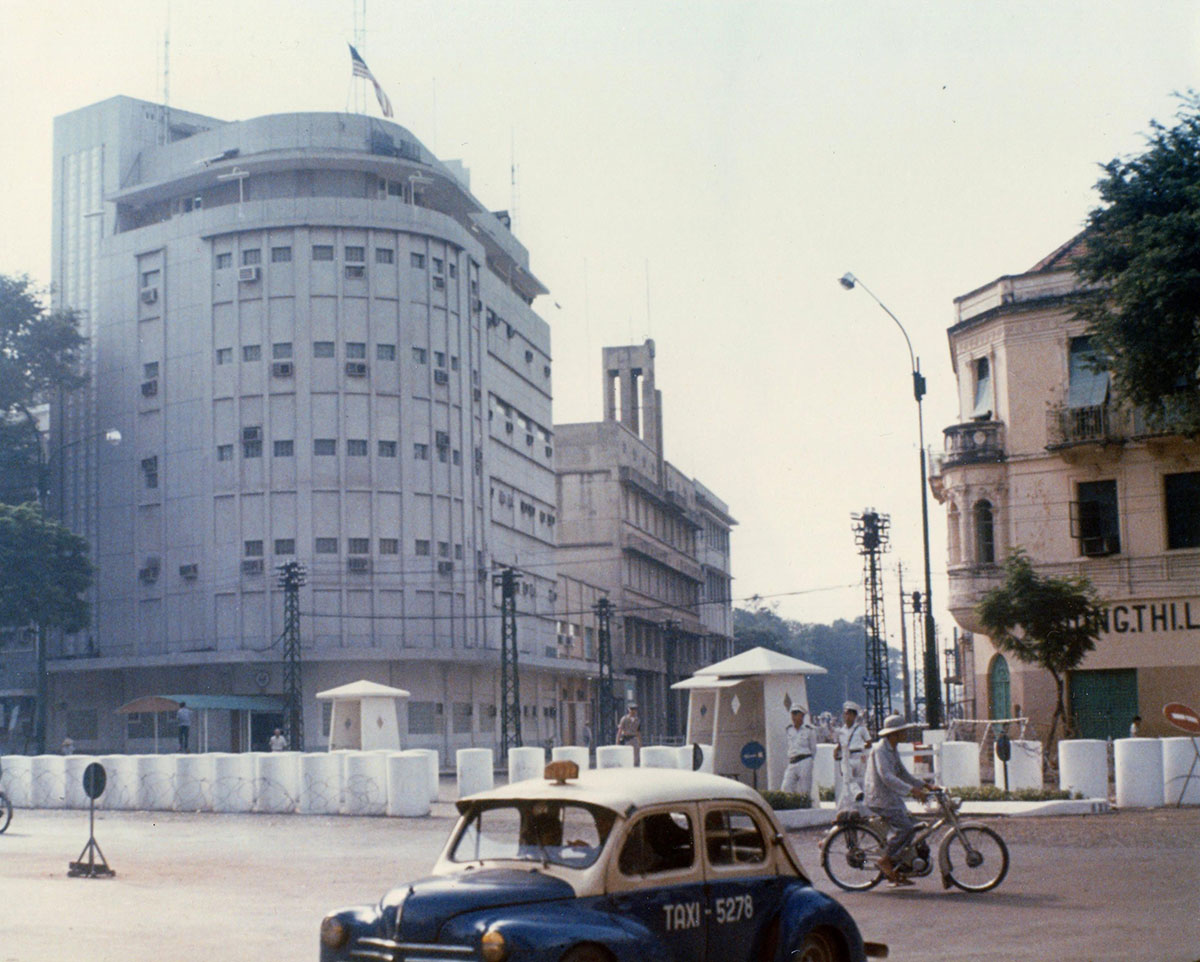
Saigon Embassy Reconstructed: Reconstructed former Saigon embassy, circa 1966
Anne Pham
click here to return to the top of the page ↑
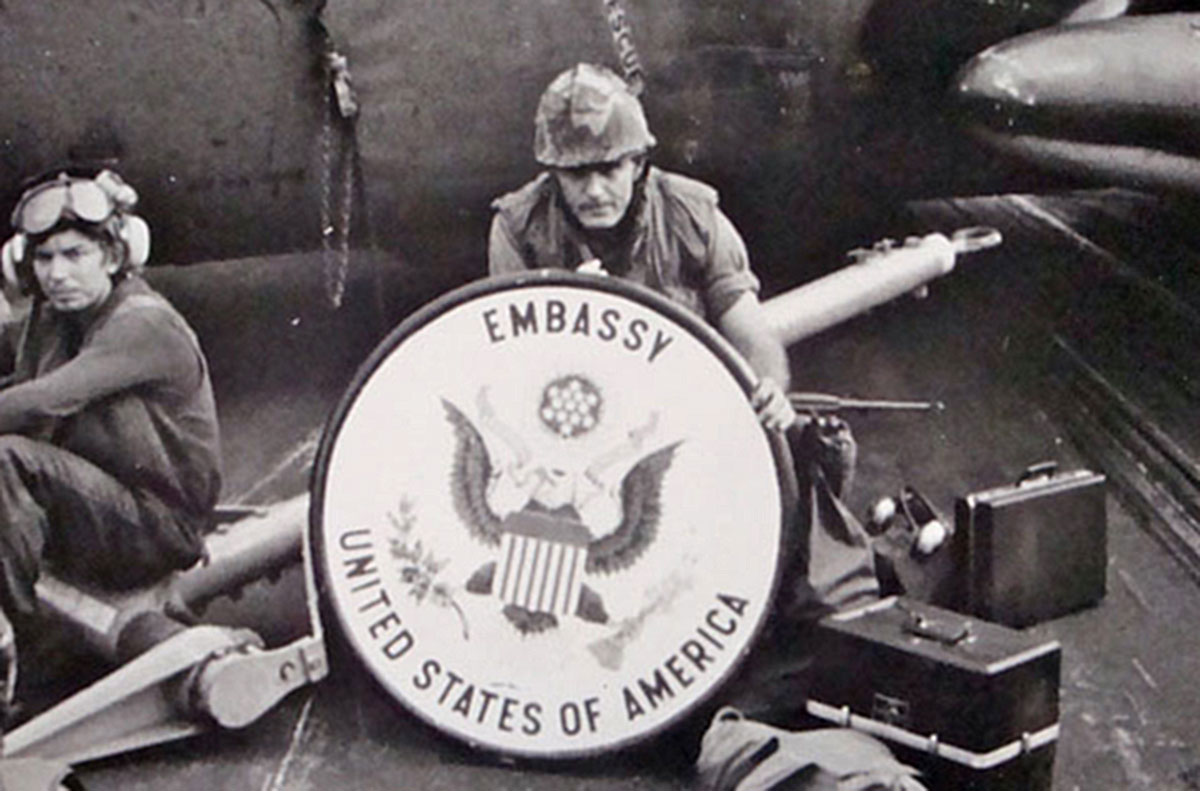
Embassy Saigon Seal- Marine holding U.S. Embassy Seal from Saigon.
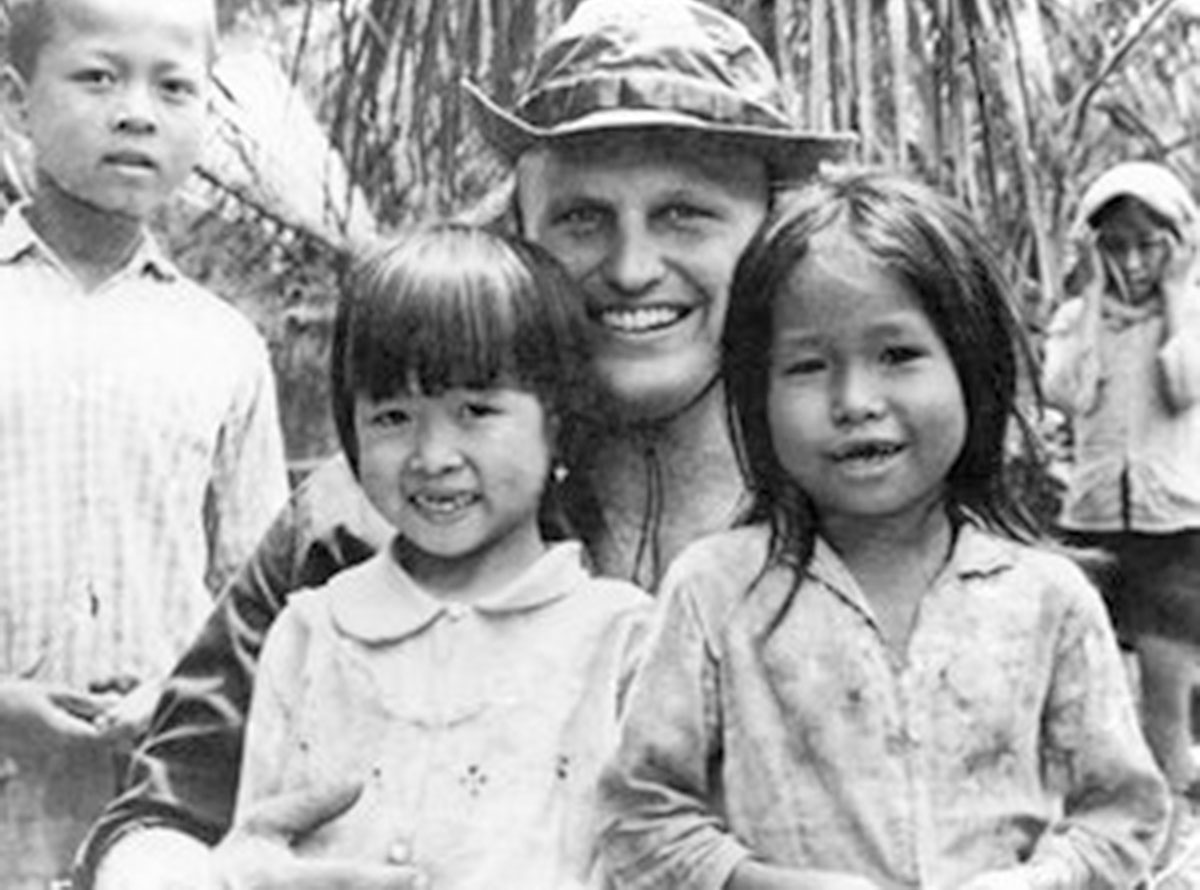
Refugee Children - Former Deputy Secretary Armitage with village refugee children.

Guam Refugee Camp - Refugees in Guam. Anne Pham’s family and others were processed here before going to Fort Chaffee. Most of the 1975 refugees went to Guam first before going on to refugee camps in the United States.
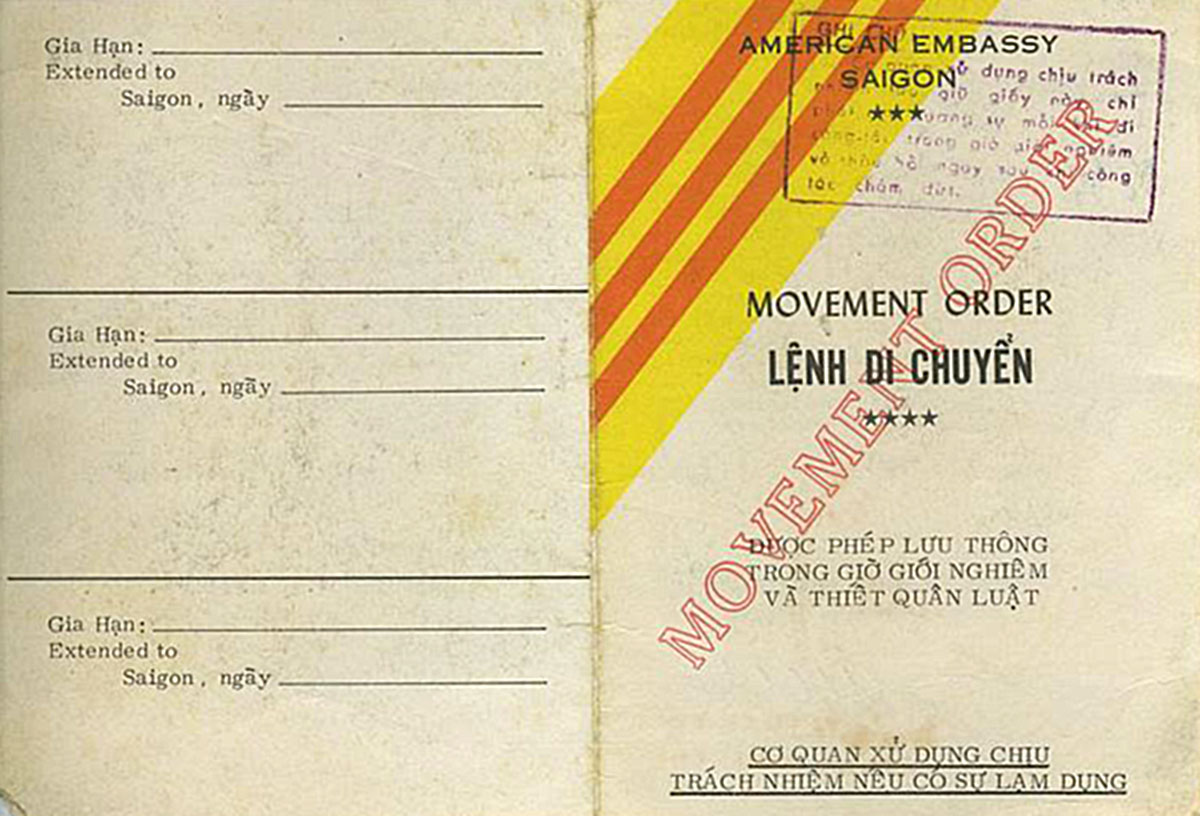
Embassy Movement Order - Because of the curfew imposed during the final days of the war, the U.S Embassy issued movement orders that allowed people to travel within Saigon and elsewhere during the curfew.
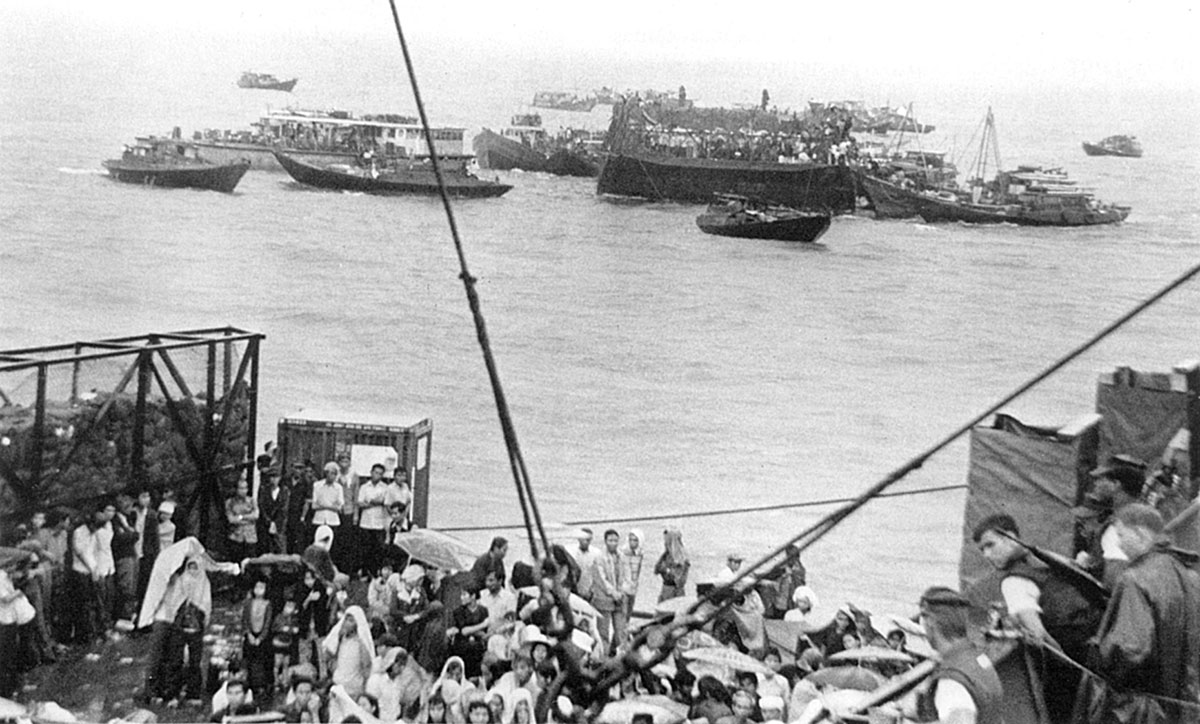
Refugees on Board - Refugees on board Sgt. Andrew Miller ship that rescued Anne Pham’s family.
James Rosenthal
click here to return to the top of the page ↑
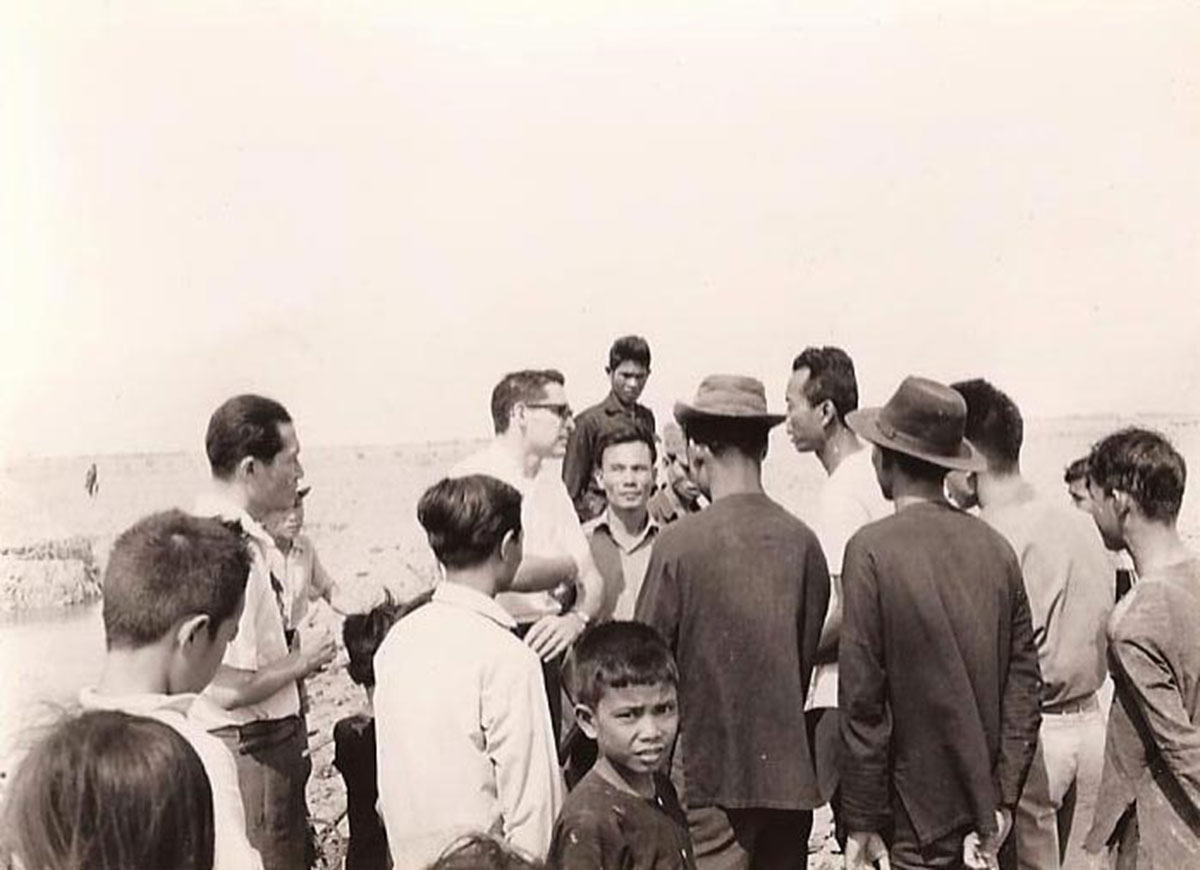
Crowd - FSO Jim Rosenthal talking with Vietnamese farmers in the Mekong Delta in 1962.

Jeep - FSO Dick Teare, in 1965, at the wheel of the unit’s primary mode of transportation.
Dick Virden
click here to return to the top of the page ↑
Dick Virden is a second tour Foreign Service Officer assigned as a Wireless File Correspondent in Saigon from July 1970-October 1971.

Wireless File Correspondent Dick Virden talks with a university professor at Hue University in November 1970 about the aftermath of the horrific battle in that ancient imperial city during the 1968 Tet Offensive.
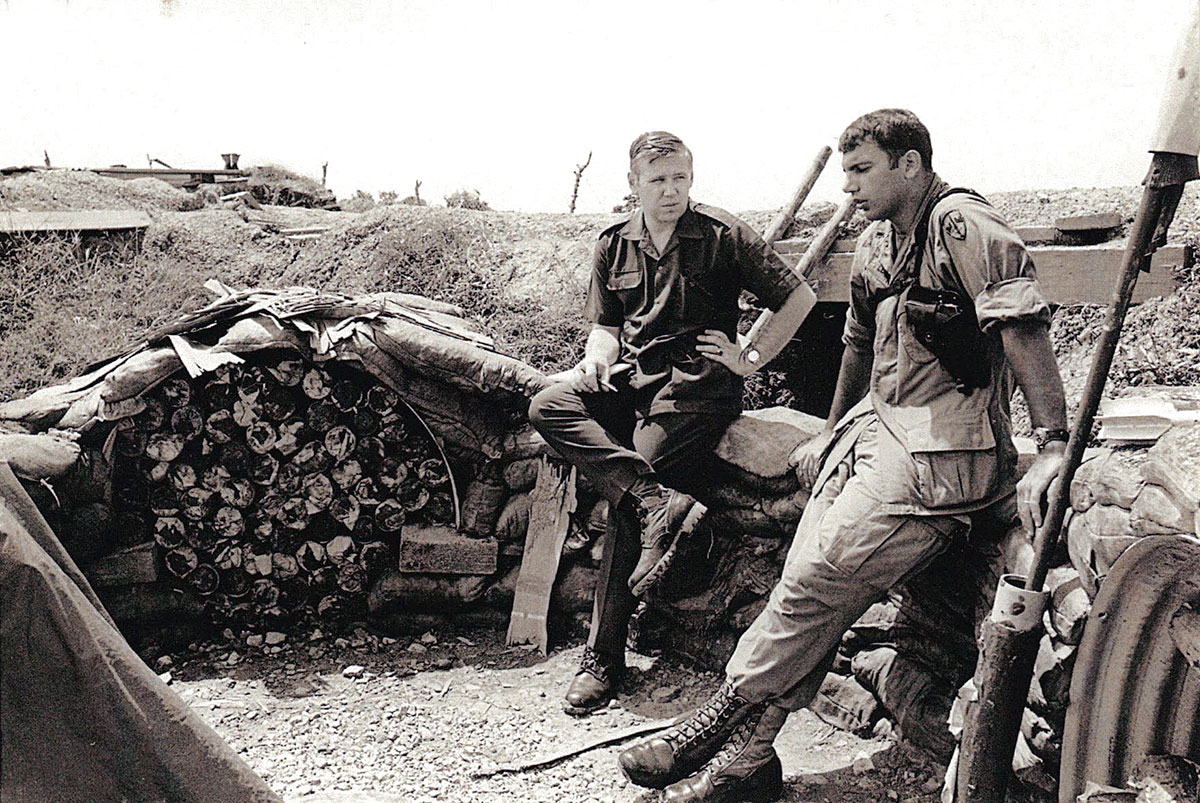
Interview - Wireless File Correspondent Dick Virden interviews a U.S. Army major in the Mekong Delta of South Vietnam in late 1970.
In Between
James Hall
click here to return to the top of the page ↑
James H. Hall served as a U.S. Army Captain in combat as a military adviser in the Mekong Delta from 1965-1966. He went on to serve with USAID CORDS as an adviser to a District Chief in the Mekong Delta from 1970-1972, and as an economic officer in the Embassy/USAID Joint Economic Office in Saigon from 1973-1975. He opened the U.S. Liaison Office in Hanoi, serving there between 1994-1997, first as Chief of the Liaison Office and subsequently as DCM to Ambassador Douglas B. “Pete” Peterson
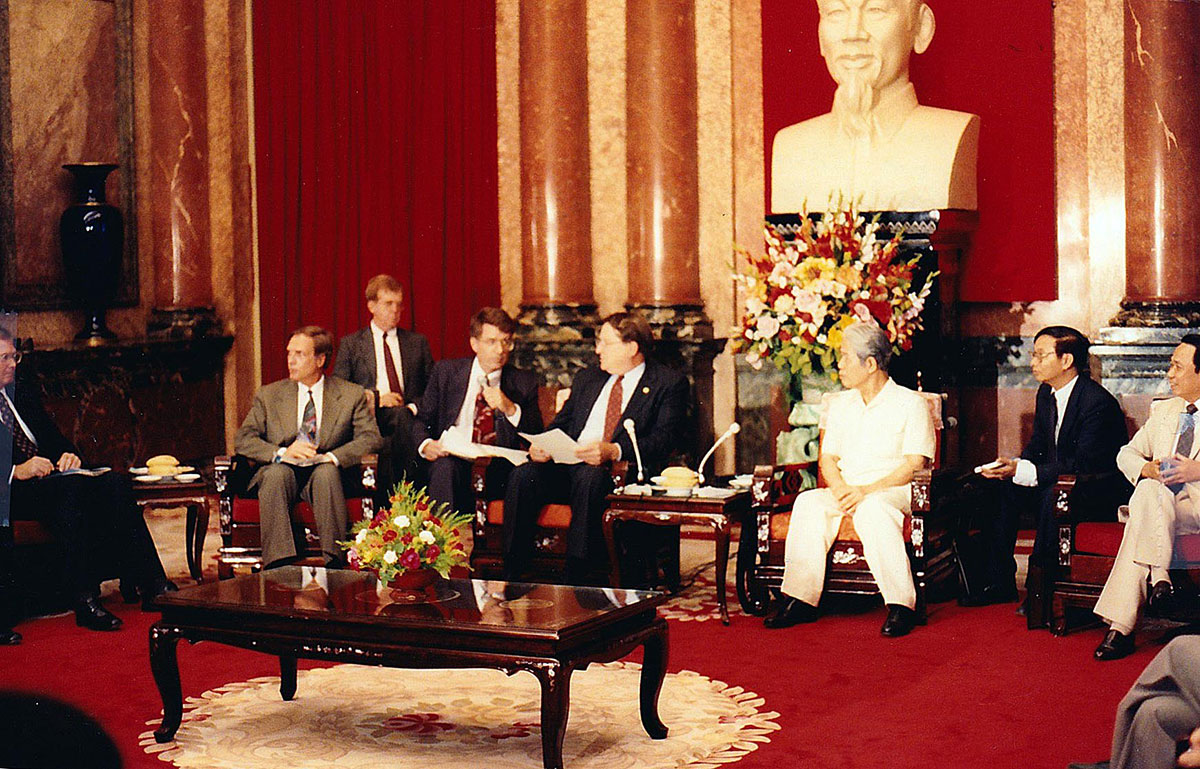
Viet Nam Communist Party General Secretary Do Muoi meeting on July 17, 1992 with a Presidential Delegation headed by Deputy Secretary of Veterans Affairs, Hershel Gober, July 17, 1993. Seated L-R: Lieutenant General Michael E. Ryan, US Air Force, Assistant to the Chairman of the Joint Chiefs of Staff; Winston Lord, Assistant Secretary of State for East Asia and Pacific Affairs (EAP); James H. Hall, Director EAP/VLC; Chip Schofield, Interpreter, State Department; Hershel Gober; Do Muoi (d. 12/29/1997); Vietnamese Government interpreter, Le Mai, Deputy Foreign Minister (d. 6/12/1996).
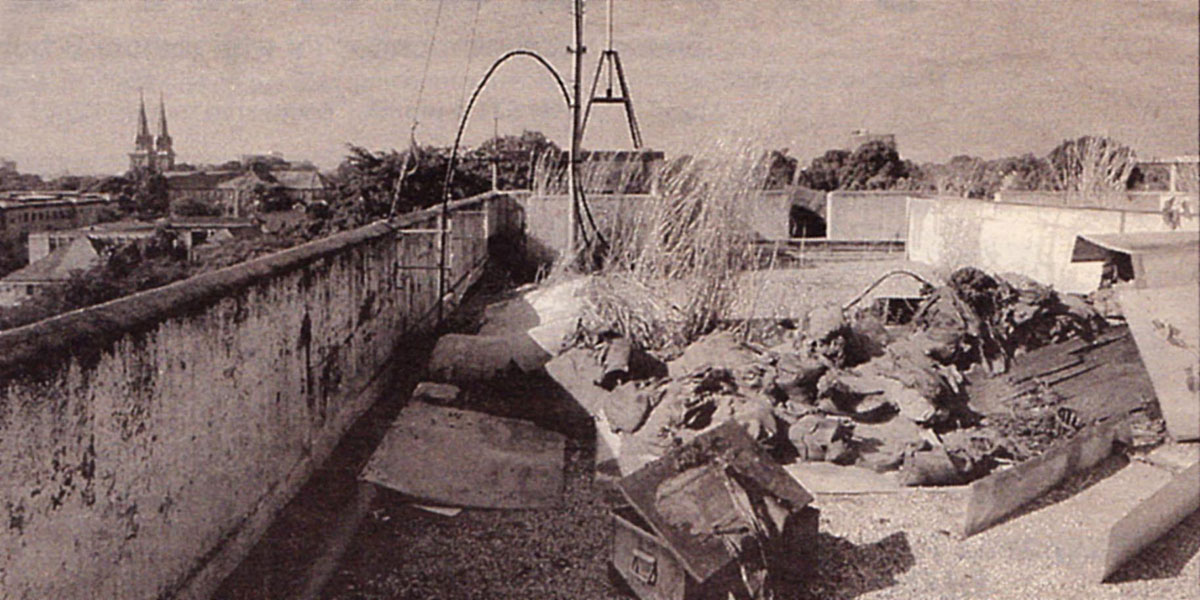
Newspaper clipping showing Embassy Saigon in 1995 - The roof of the former American Embassy in Saigon, from New York Newsday, January 29, 1995.
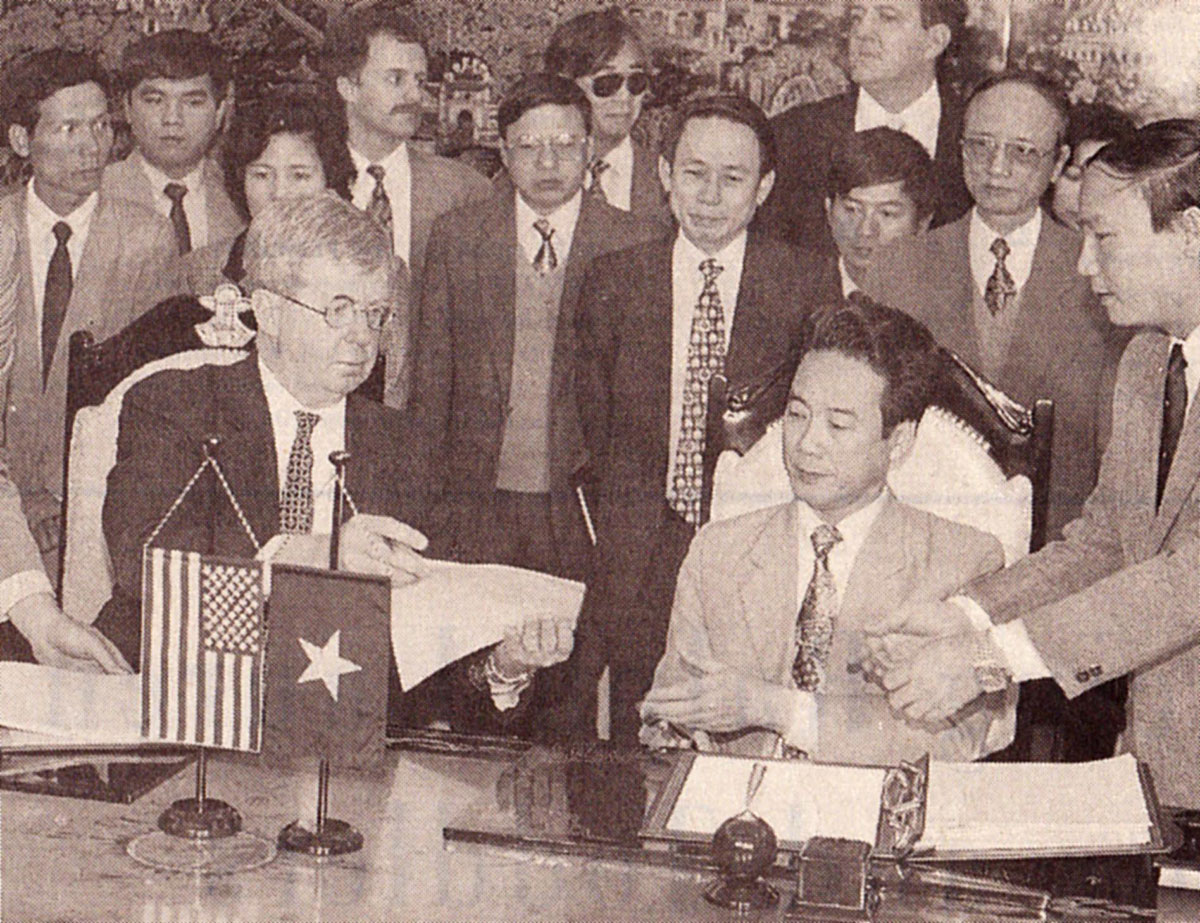
Newspaper clipping showing the signing of an agreement on return of diplomatic properties and establishment of Liaison Offices in Hanoi and Washington – New York Times, January 29, 1995.
Richard Sacks
click here to return to the top of the page ↑
Pictures taken from 1995-2000 in Hanoi Embassy.
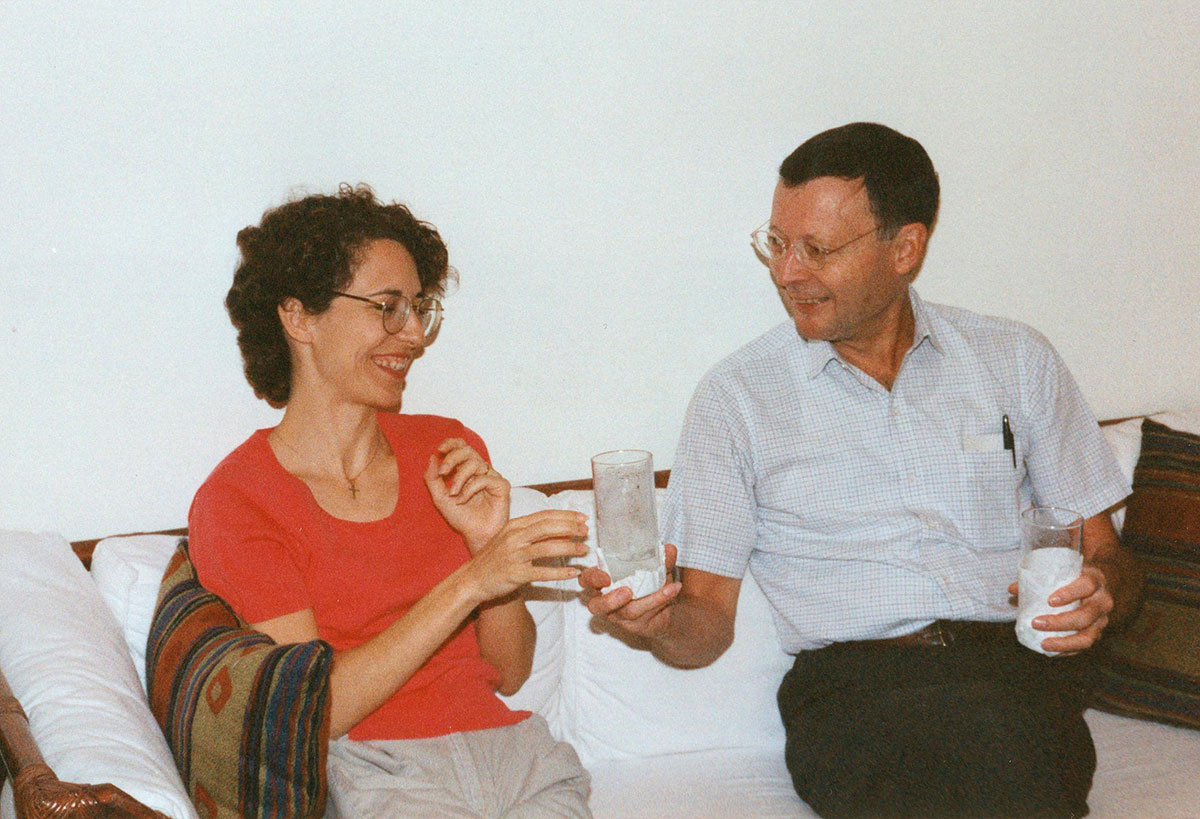
FSO Kristin Bauer with Charge Desaix Anderson (1995-1996)

Barbara and George H. W. Bush with Charge Desaix Anderson at Hanoi Embassy, September 1995.

USTR Trade negotiator Joe Damond with Economic Specialist FSN Nguyen thi Bich ha, Hanoi, December 1996.
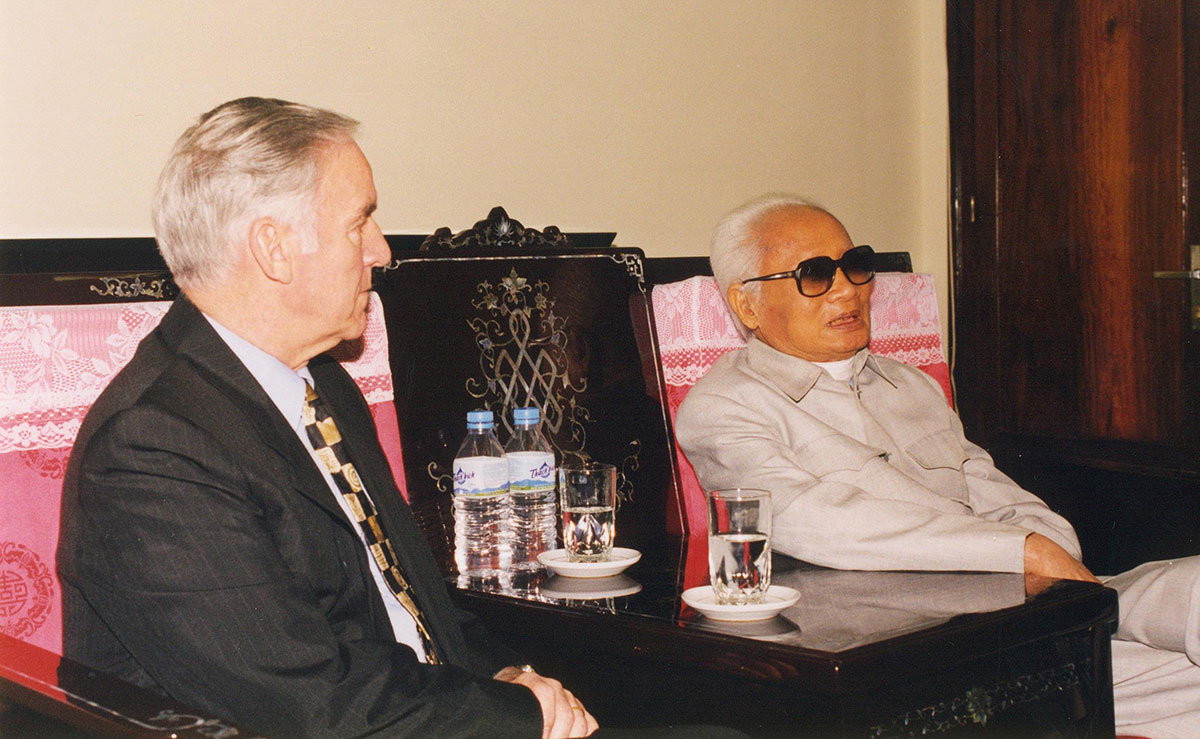
Ambassador Pete Peterson with former Vietnamese Prime Minister Pham Van Dong, April 1999.
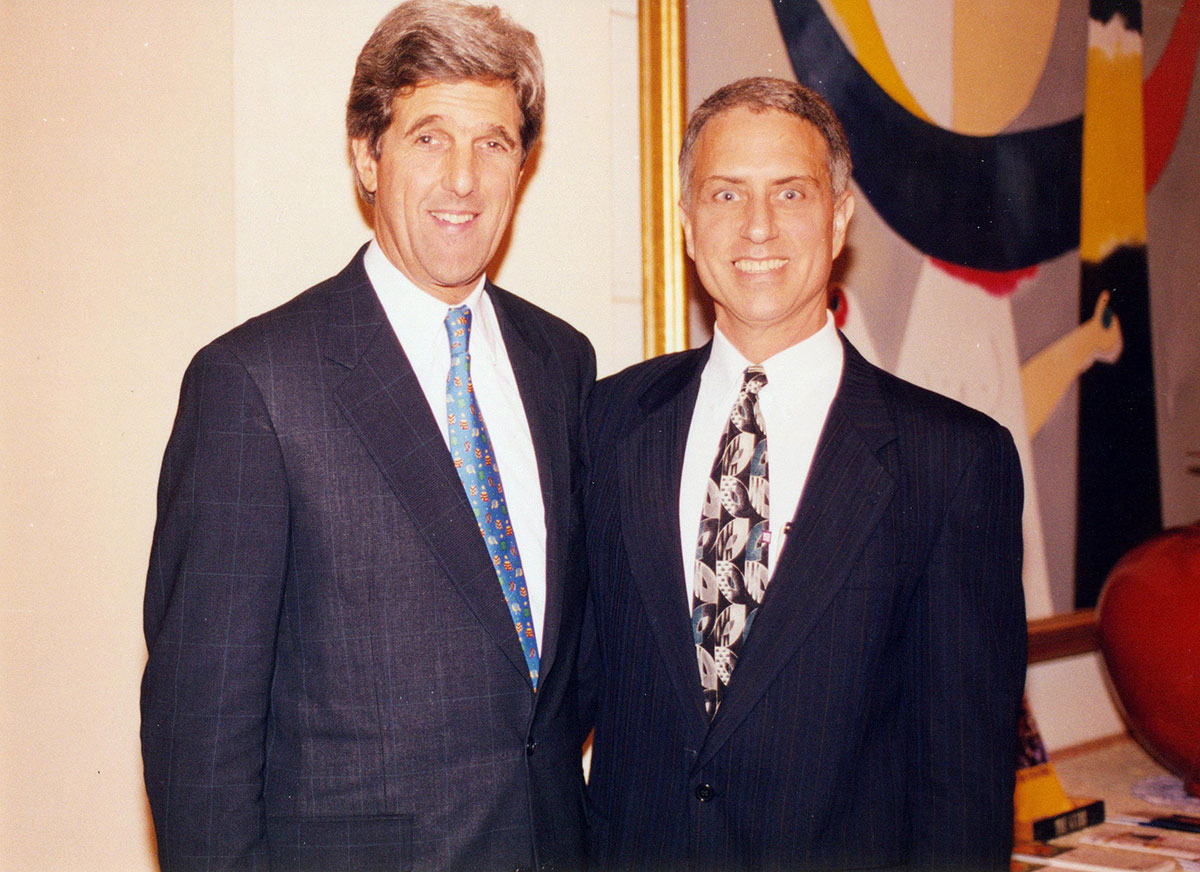
Senator John Kerry with FSO Richard Sacks, Hanoi, Daewoo Hotel, December 1997.
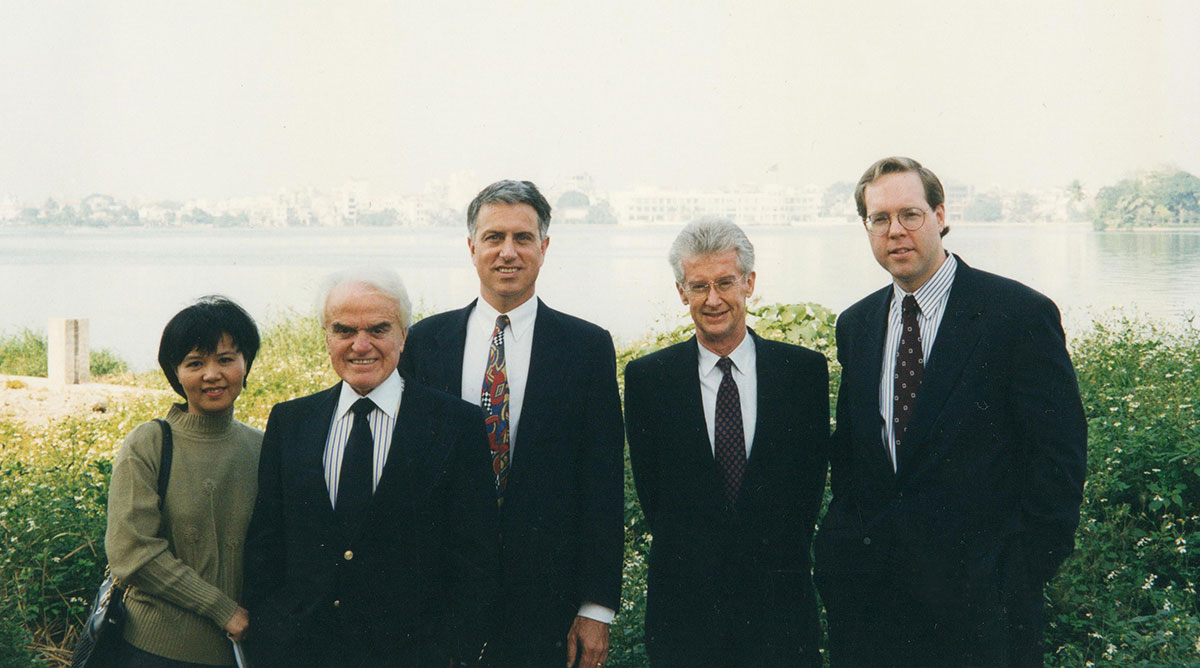
(left to right) Economic Specialist FSN Bich Ha, Morion Picture Association President Jack Valenti, FSO Richard Sacks, MPA Representative Michael Connors, MPA Executive Vice President William Murray, Hanoi, with West Lake in background, Spring 1997.

Gershom Sacks (right) with friend Kento Shiiki (left), Hanoi, October 1996.
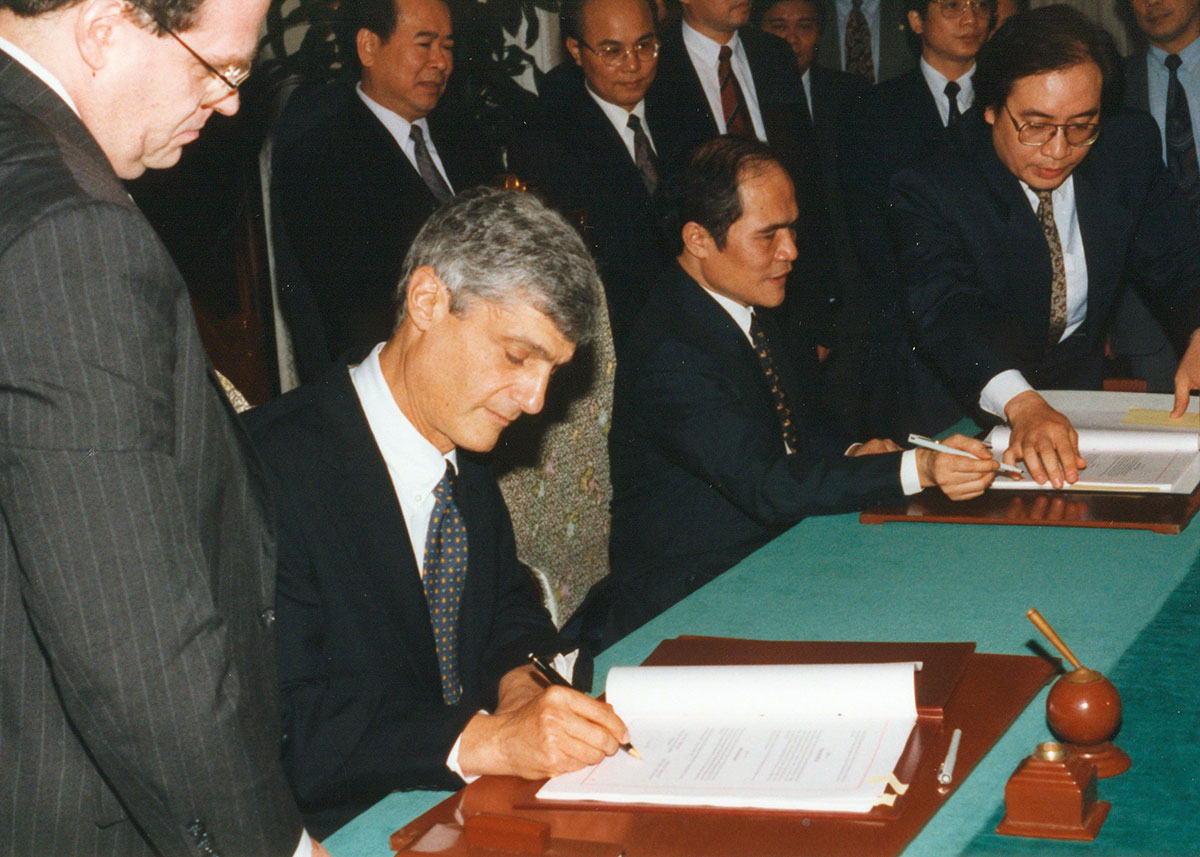
Treasury Secretary Rubin with Vietnamese Finance Ministry counterpart signing U.S.-Vietnam Debt Agreement, Spring, 1996.

USTR Charlene Barshevsky poses with members of Saigon Economic Institute, November 2000.
Modern
Clayton Bond
click here to return to the top of the page ↑
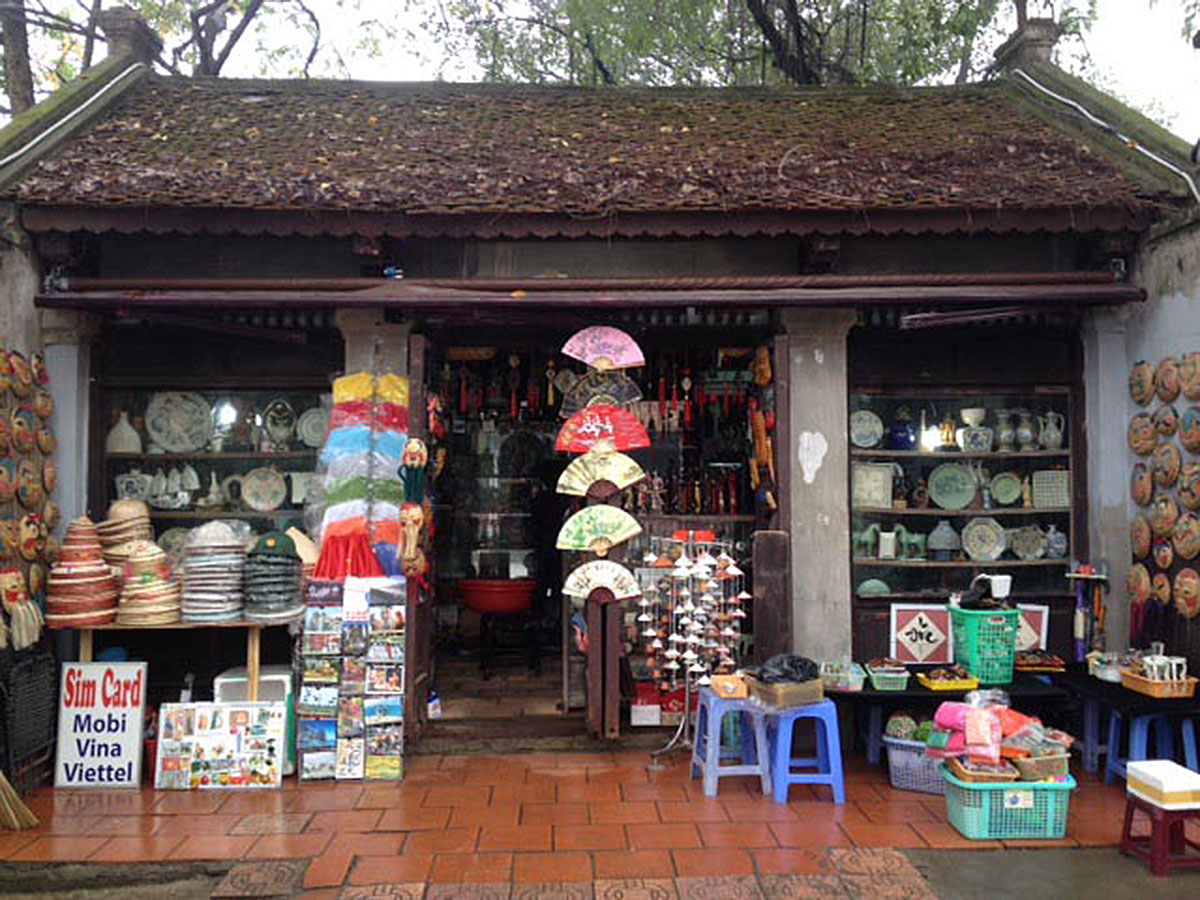 /sites/default/files/fsj2015april_vietnamSupplement_img054.jpg" />
/sites/default/files/fsj2015april_vietnamSupplement_img054.jpg" />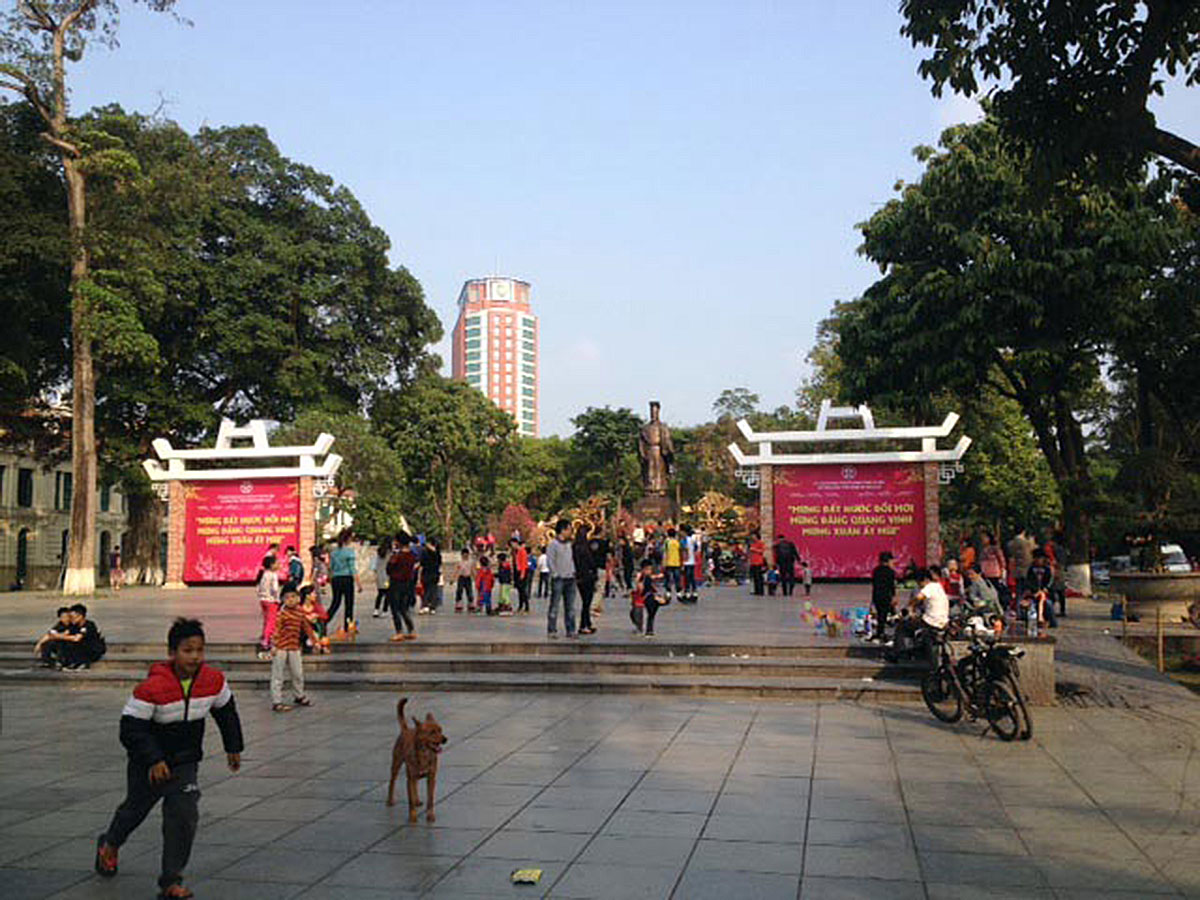 /sites/default/files/fsj2015april_vietnamSupplement_img055.jpg" />
/sites/default/files/fsj2015april_vietnamSupplement_img055.jpg" />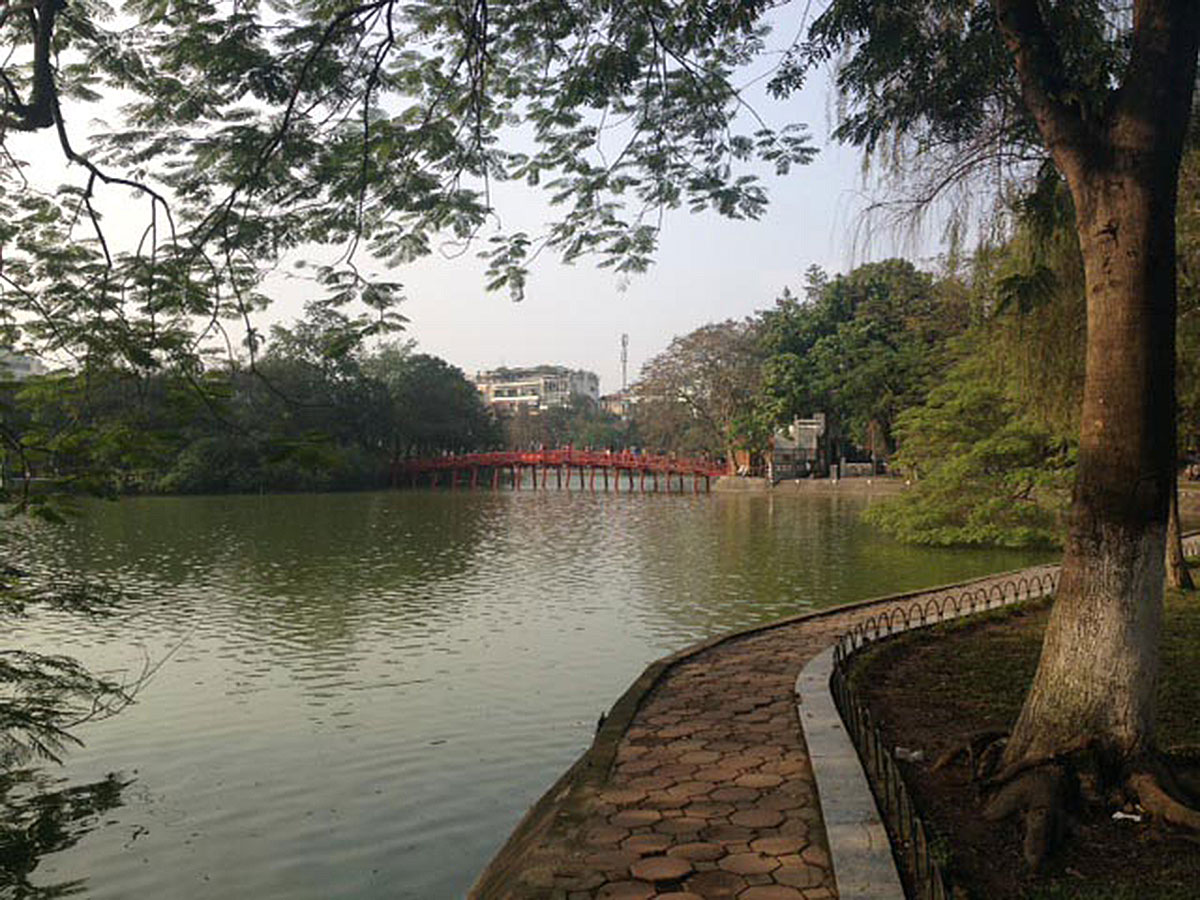 /sites/default/files/fsj2015april_vietnamSupplement_img056.jpg" />
/sites/default/files/fsj2015april_vietnamSupplement_img056.jpg" />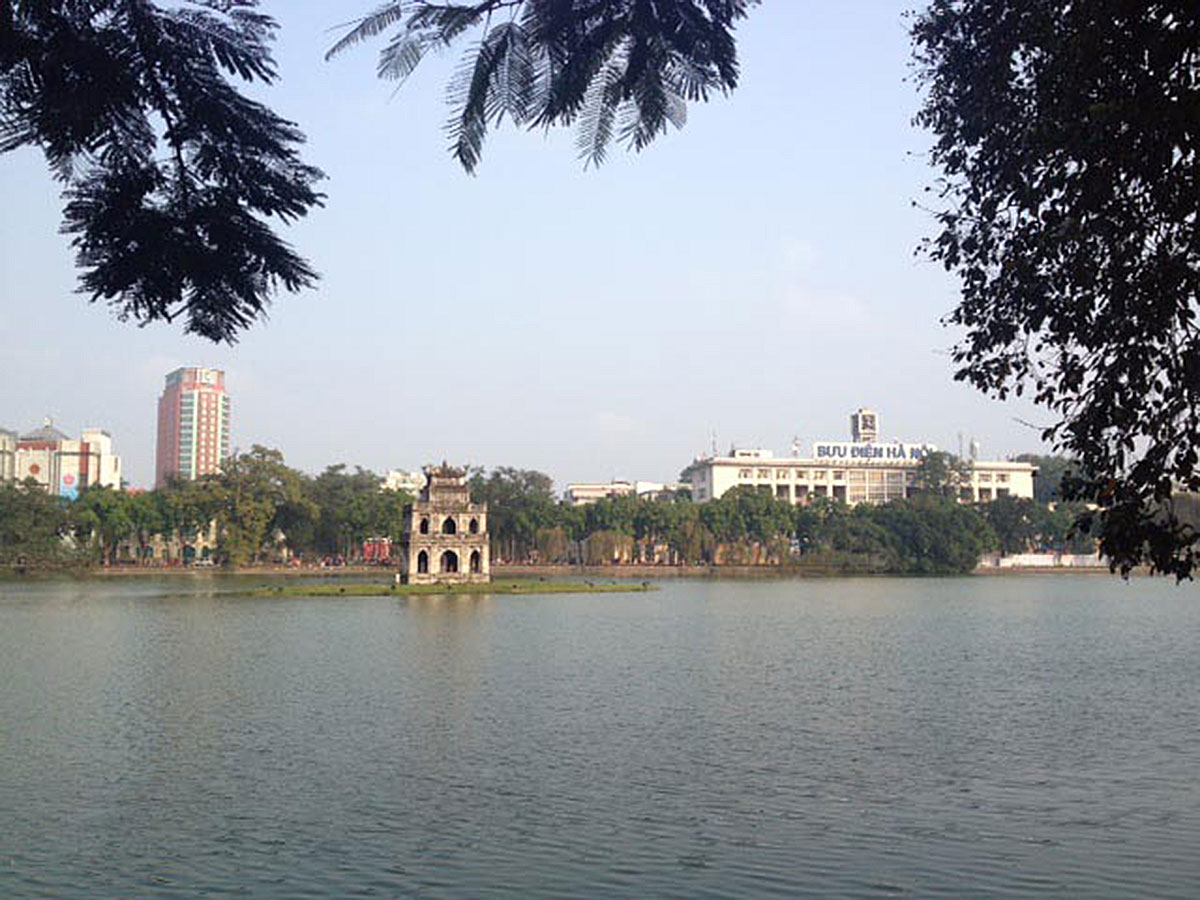 /sites/default/files/fsj2015april_vietnamSupplement_img057.jpg" />
/sites/default/files/fsj2015april_vietnamSupplement_img057.jpg" />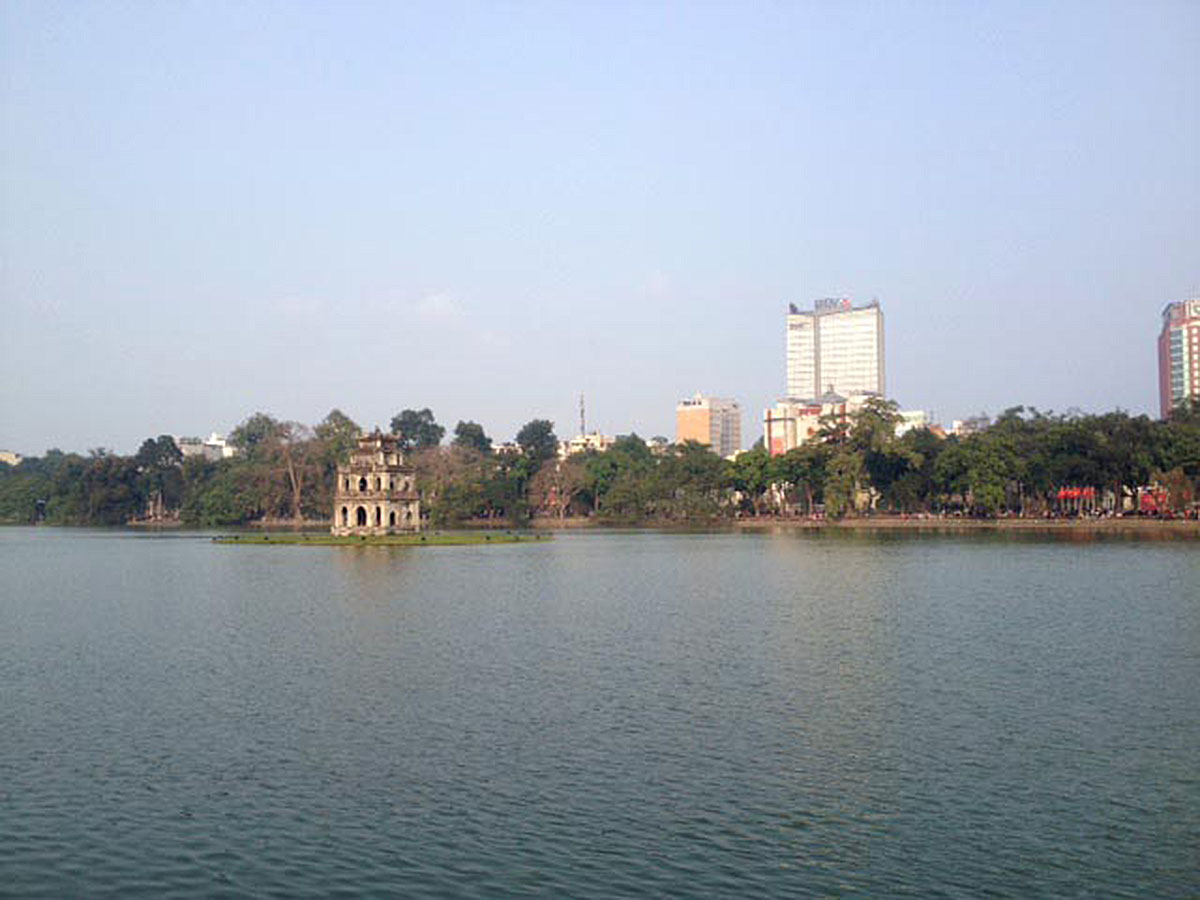 /sites/default/files/fsj2015april_vietnamSupplement_img058.jpg" />
/sites/default/files/fsj2015april_vietnamSupplement_img058.jpg" />Daniel Carl
click here to return to the top of the page ↑
Daniel Carl served as an Economics/Labor Officer at U.S. Embassy Hanoi from 2012-2014.

Hanoi skyline: This Hanoi skyline view will be familiar to Embassy staff who lived near Trúc Bạch Lake. Spring was an amazing time for sunset photography. Afternoon rains rinsed away much of the air pollution leaving unobstructed views of the mountains 30 miles to the west. From the 19th floor of my apartment, the view was serene.

Woman with baskets: On the street outside the apartment, life was anything but serene. Vietnam’s streets have an incredible energy because so much of everyday life takes place outside. Here, an elderly woman with her kitchen-in-a-basket crosses the street as a motorbike buzzes behind her. Vietnam is a land of micro-entrepreneurs and this woman was likely on her way to set-up a street food kitchen on the shore of Trúc Bạch Lake– a popular evening dining location for locals.

Woman weaving: We came across this woman weaving with a backstrap loom while hiking in Hà Giang Province. She may have been working on a textile for nearby Đồng Văn market. The weekly Đồng Văn is a carnival of colors where different ethnic minorities, with colorful traditional clothes, come together to sell their unique woven goods.
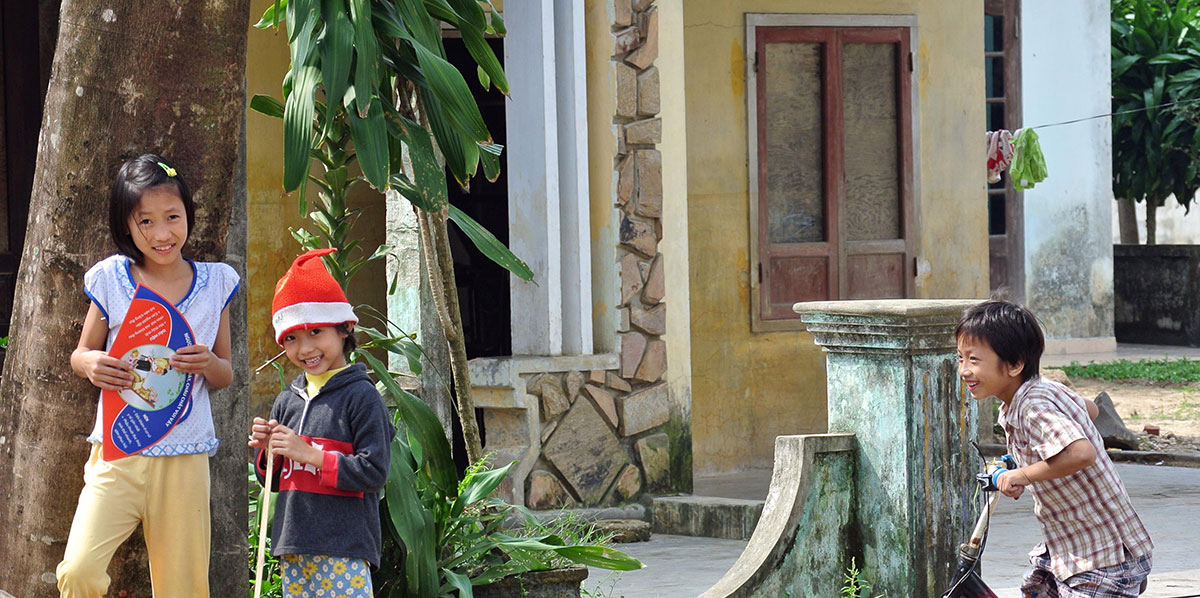
Photo taken December 24, 2012, in Quang Nam Province, en route to the My Son archeological site. The photo was taken the day before Christmas and the young girl was playing by the side of the road in her Santa hat.
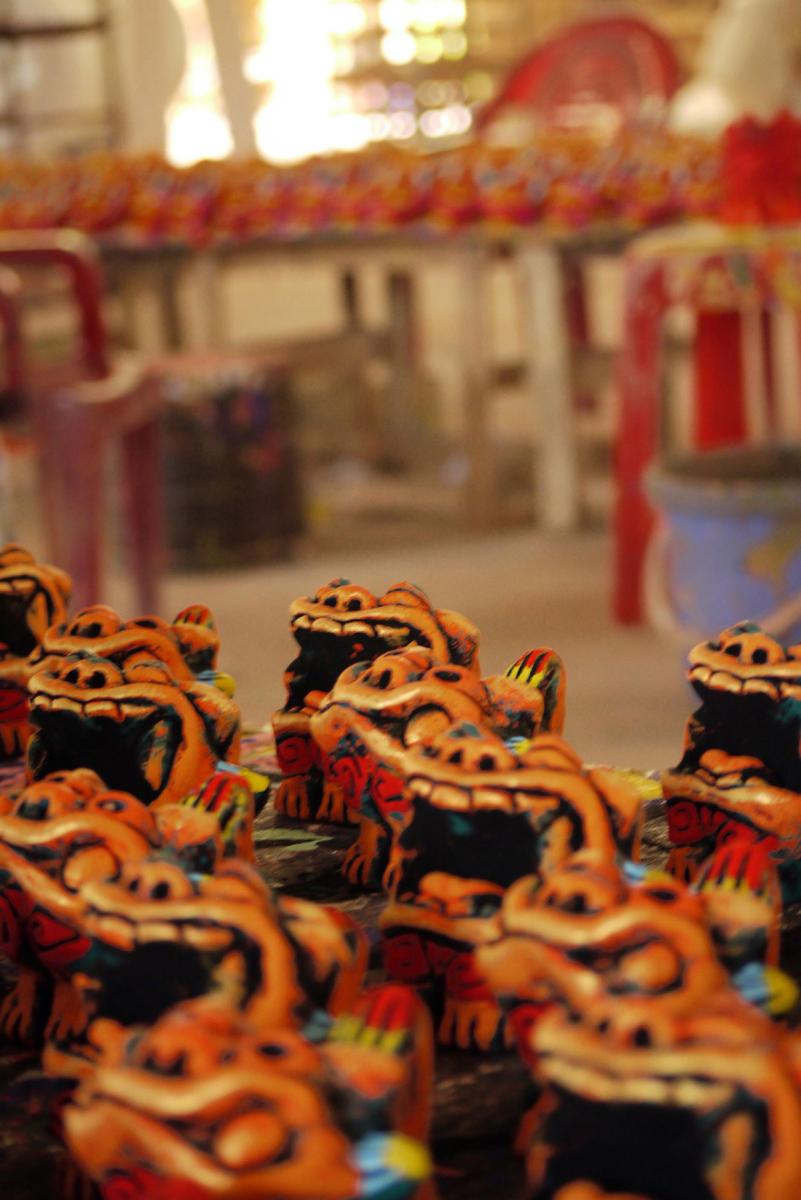
Clay figures: This photo was taken on July 28, 2012, at a pottery village outside Hanoi. The owner had thousands of these colorful clay figures drying before being exported to Japan.
Bada Erdogan
click here to return to the top of the page ↑
Bada Erdogan served two tours back to back in Hanoi, Vietnam from 2009-2013, and is currently the Assistant Ambassador to Shari Villarosa at the U.S Embassy to Mauritius and Seychelles.
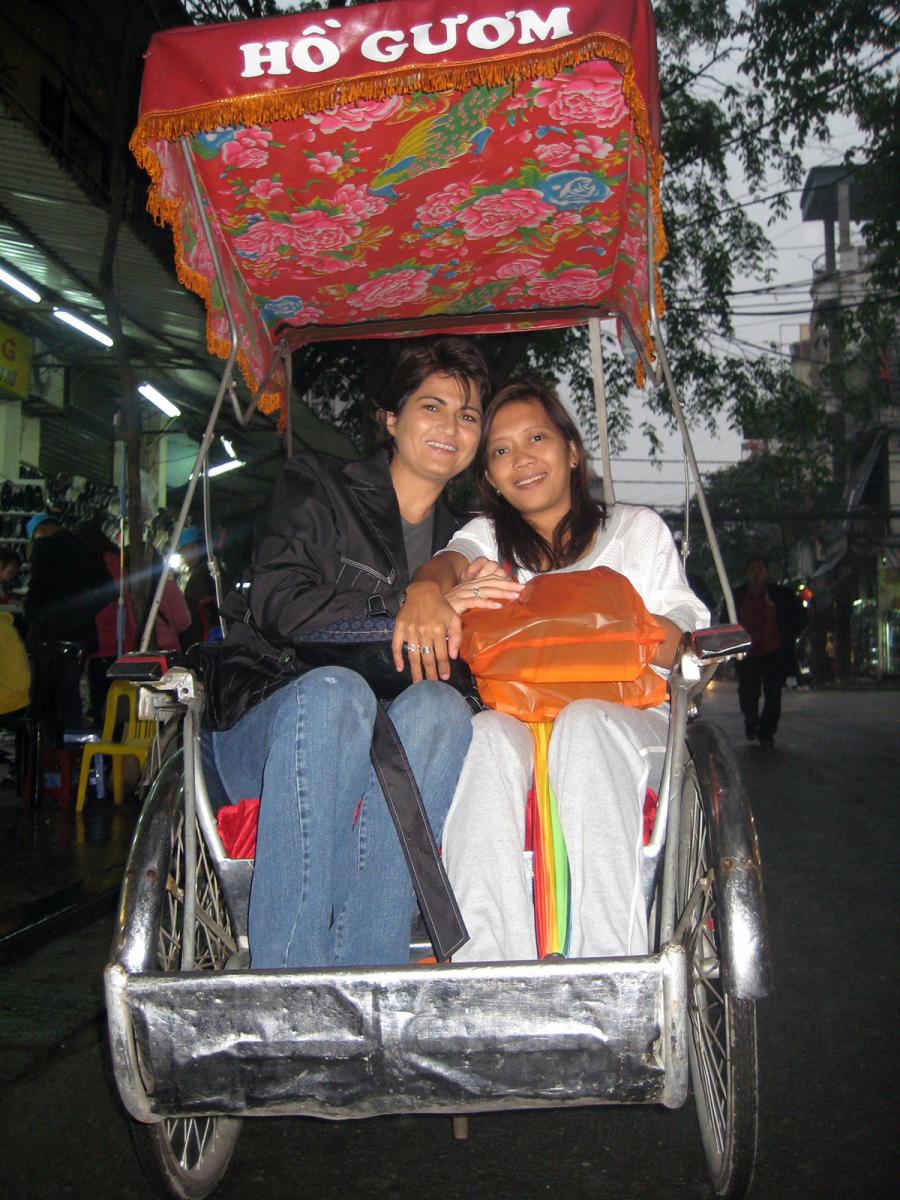
Riding a cyclos: Riding a cyclos around town is a must do for tourists and anyone living in Vietnam.

Trying to fit in: My spouse Debbie Estanislao and I enjoyed our years in Vietnam very much. We had fun wandering around the Old Town/French Quarter, and tried to fit in by wearing headgear and selling pineapple.
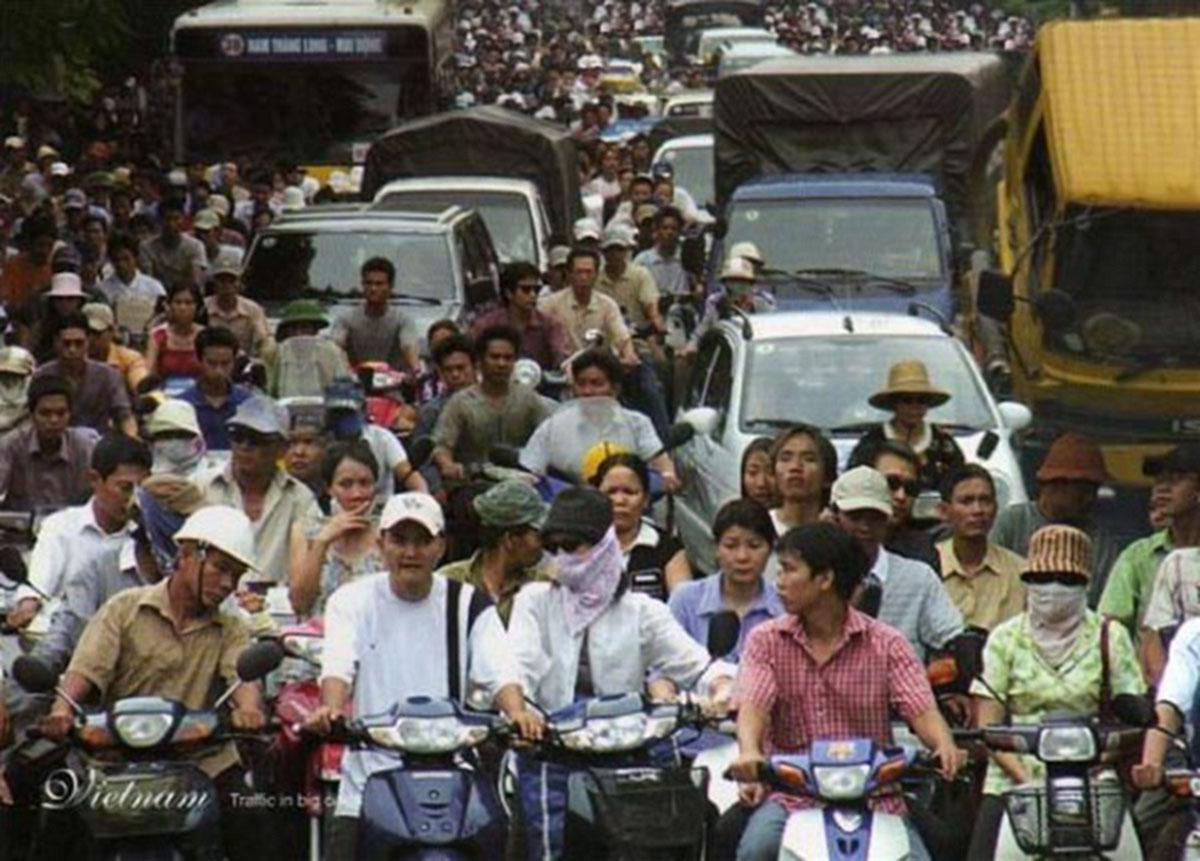
Traffic in Hanoi: The traffic in Hanoi was my initial culture shock, and this is not an exaggerated picture. This is almost the daily image of Lang Ha street going to work. I remember my first day into work in our Embassy just looking out and staring at the traffic and thinking “this is crazy”, but believe it or not, we got used to it and even managed to cross the street to get to the restaurants on the other side for lunch.
Adam Fields
click here to return to the top of the page ↑
Adam Fields is a second tour State Department political coned officer serving in the Consular Section in Kuala Lumpur. His first tour was as an Economic Officer in Hanoi.

President Trung Tan Sang and Madam Hanh: This picture was taken at the Kahala Hotel in Honolulu on November 13, 2011. Pictured are Vietnamese President Trung Tan Sang and Vietnamese First Lady Madam Hanh. Click here to read more.
John Kastning
click here to return to the top of the page ↑
John Kastning, was an Economic Officer at U.S. Embassy Hanoi from 2009 to 2011, and is now a Political Officer at U.S. Embassy Berlin.
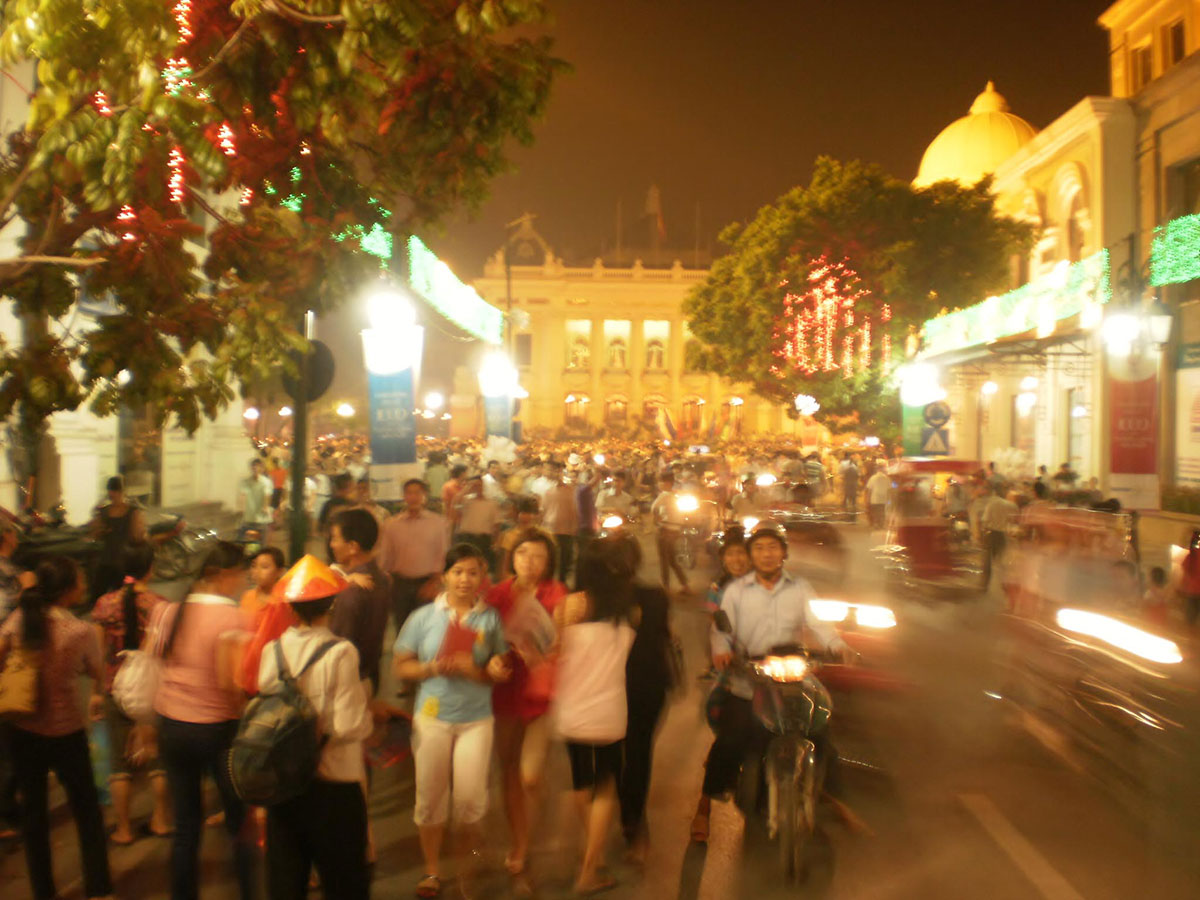
Hanoi’s 1000th Anniversary - October 2010, Trang Tien Street, looking toward the National Opera House, Hanoi. Click here to read more.
Daniel Morris
click here to return to the top of the page ↑
Daniel Morris is a USAID Foreign Service Officer currently posted to Kabul, Afghanistan.
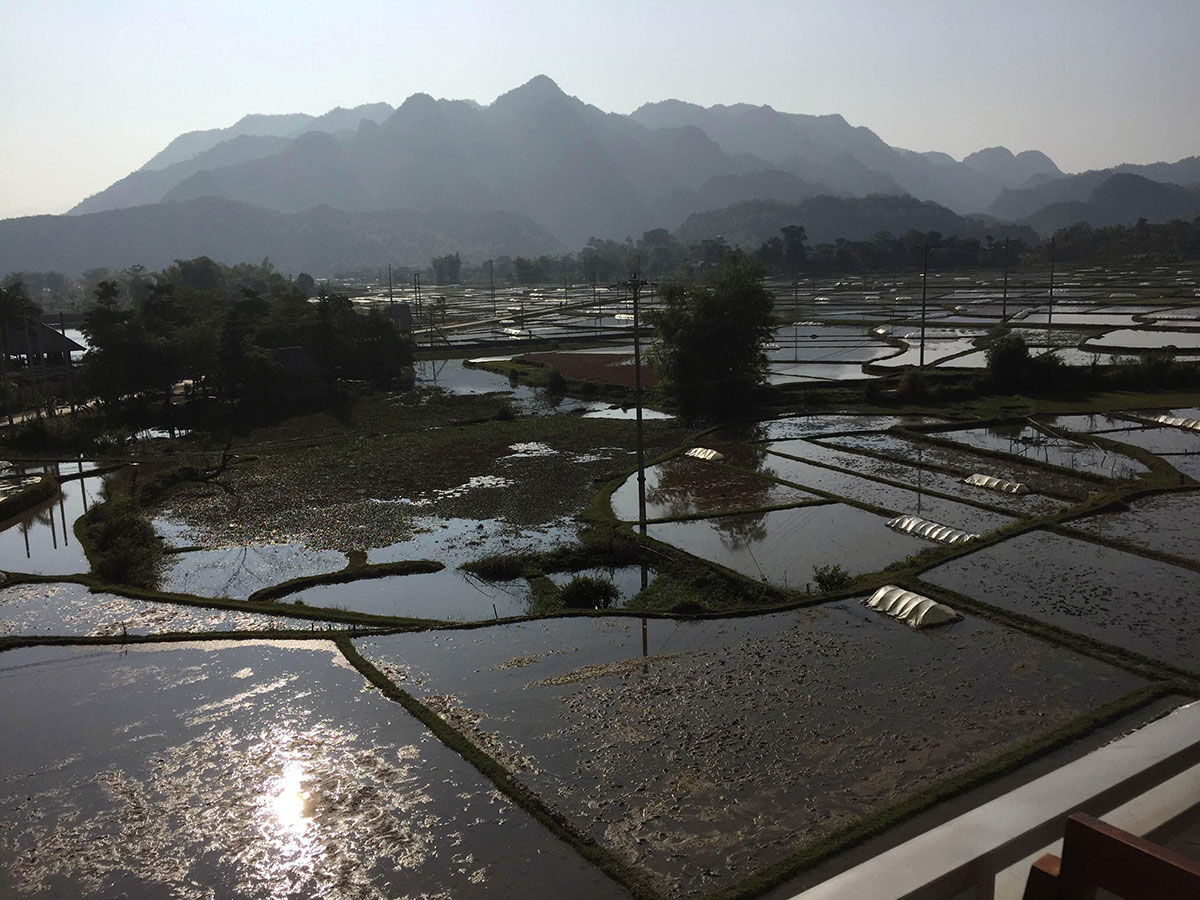
Rice Paddy, My Chau, 2015-A terraced rice paddy in the village of My Chau taken January 22, 2015.
Brett Rose
click here to return to the top of the page ↑
Brett Rose is currently serving as an Economics officer at Embassy Hanoi.

Ba Vi National Park Trip: While driving to Ba Vi National Park in an open air army jeep we came across a procession of holy relics from the pagoda to the village to celebrate the first full moon after Tet. The ladies in the outfits have to be over 70 years old (our guide told us), and gave us flowers before continuing.
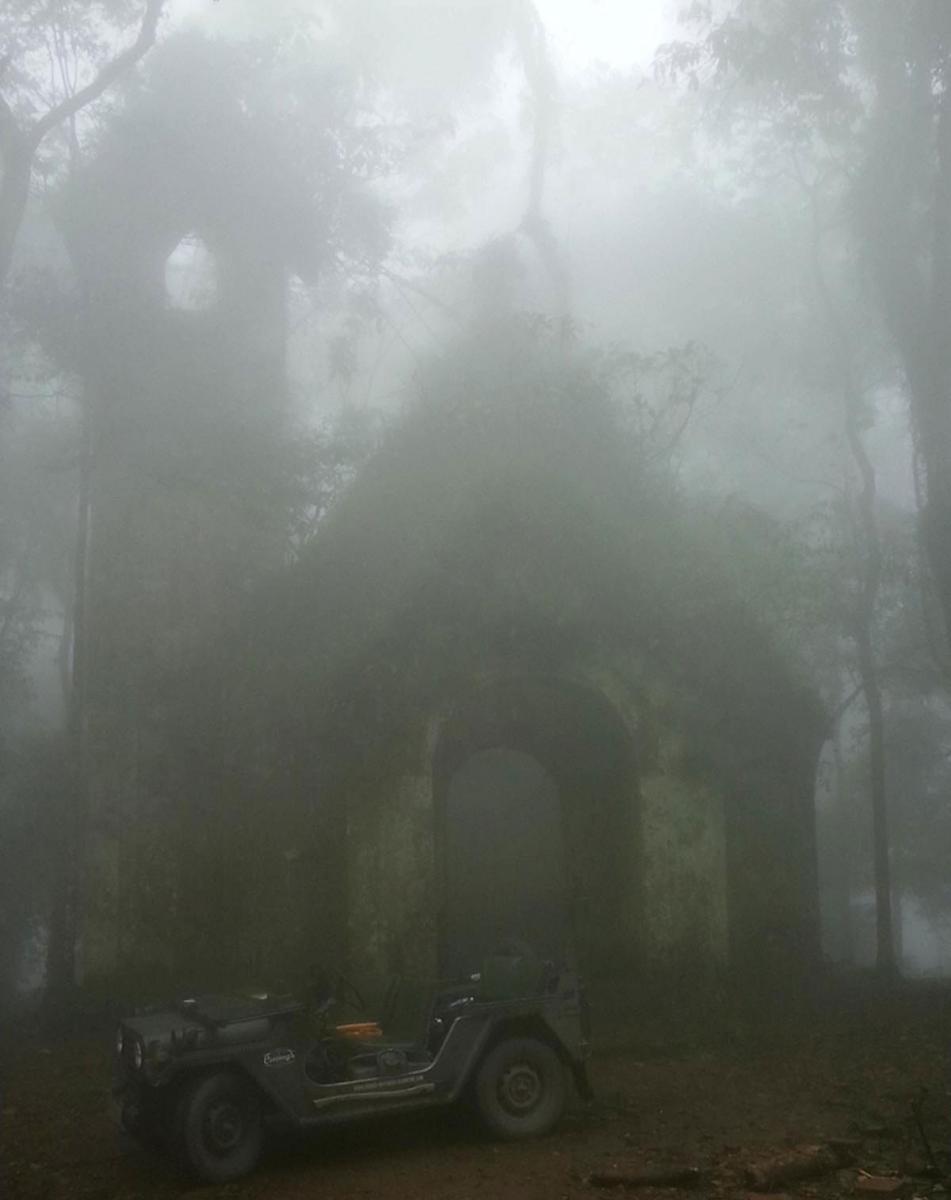
Jeep: Ba Vi Church in Ba Vi National Park, built by the French in the 1800’s when Ba Vi National Park was a hill station and retreat for senior French military officials.
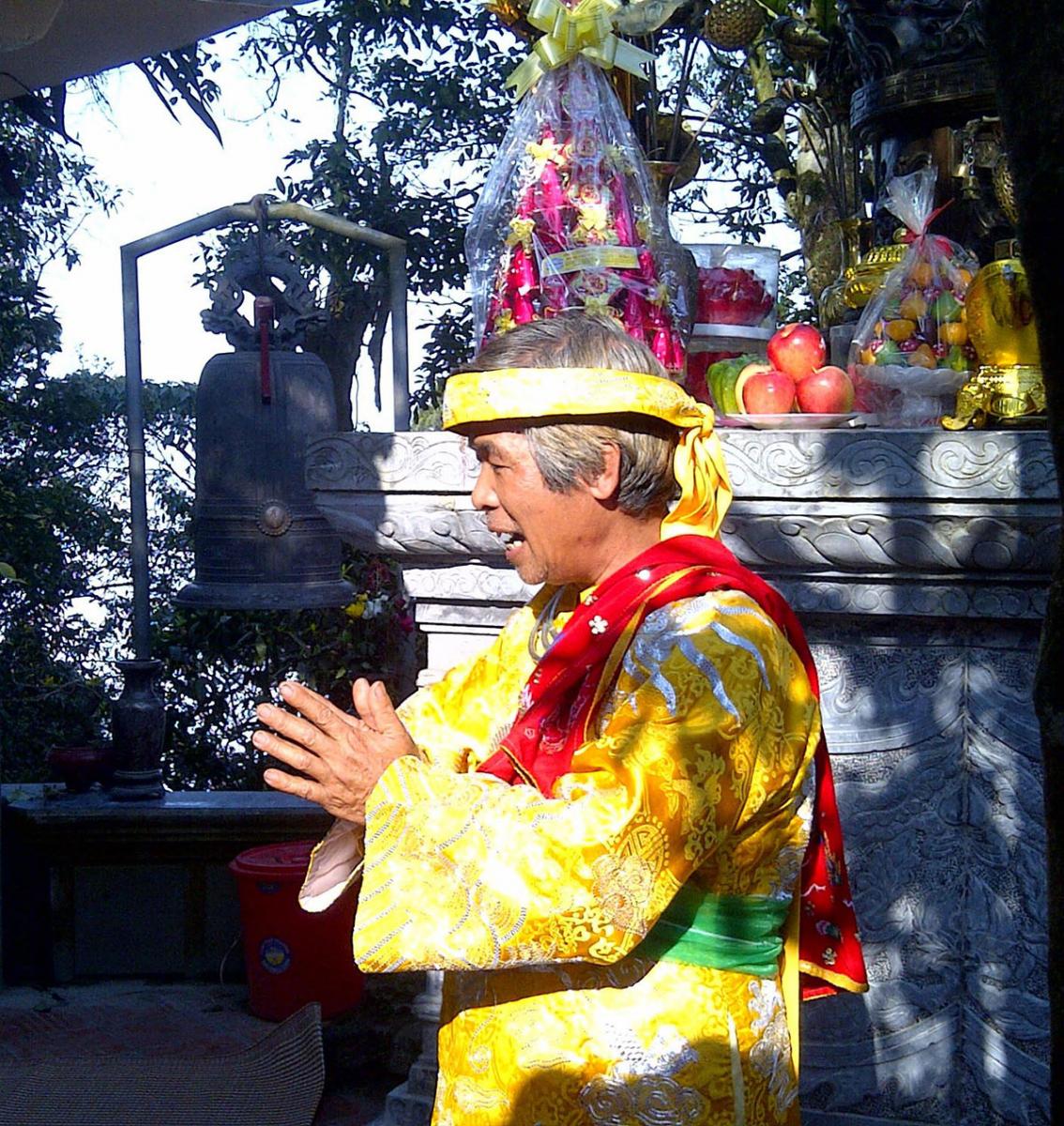
Monk praying: Monk praying at the 1,500 year old pagoda in Ba Vi National Park to celebrate the first full moon after Tet. Food is brought to the temple for the monk to bless. Afterwards, the food is brought back to the house to be eaten by the family.
Andrew Shepard
click here to return to the top of the page ↑
Andrew Shepard is currently serving at the U.S. Embassy in Hanoi as the Environment, Science, Technology, and Health (ESTH) Deputy.
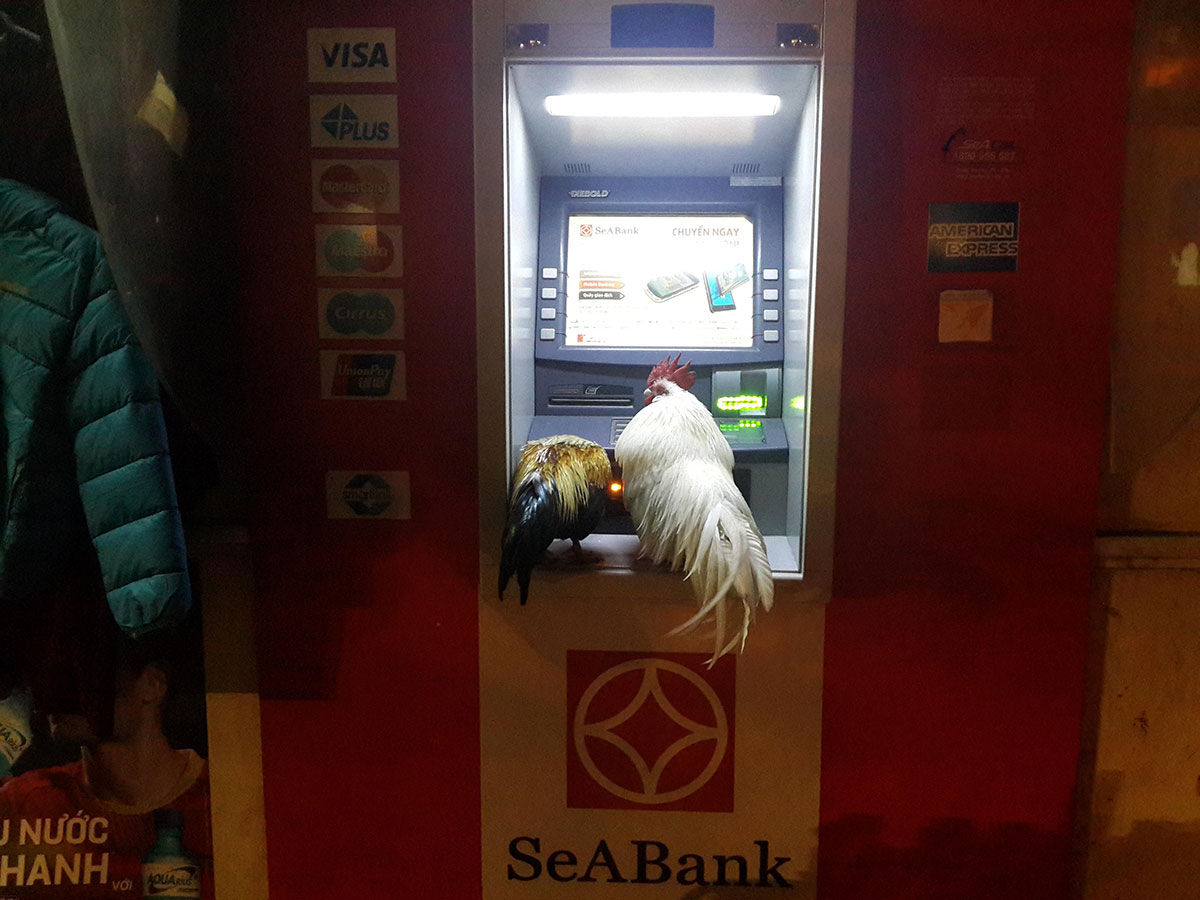
Chickens at ATM: Chickens at an ATM on Tran Phu street in present day Hanoi, February 5, 2015.

